Photo

New Post has been published on https://cryptonewsuniverse.com/a-strategic-masterstroke-blugenics-harnesses-markethives-expertise-for-the-launch-of-gaditana-original/
A Strategic Masterstroke: Blugenics Harnesses Markethive's Expertise for the Launch of Gaditana Original

A Strategic Masterstroke: Blugenics Harnesses Markethive's Expertise for the Launch of Gaditana Original

Experience the game-changing potential of Markethive, the first-ever market network built on blockchain technology. With its decentralized and transparent nature, this groundbreaking innovation empowers Blugenics, a company dedicated to its customers and the creator of Gatitana Original, the purest superfood on earth, to connect with customers like never before. Say goodbye to traditional marketing methods and hello to a new era of customer acquisition.
Blugenics Selects Markethive For Revolutionary Customer Acquisition Initiative
After years of prayer, the divinely inspired vision for Markethive is now becoming a reality. In an exclusive and unprecedented partnership, we have established a comprehensive socket connection between Markethive and Blugenics, creating seamless inter-process communication and allowing our storefronts to link directly to their system. This milestone marks the beginning of a new era as the full potential of a fully functional market network is unleashed upon the world. This is just the beginning of our journey together, and we're excited to have you as part of this exclusive collaboration.
Markethive is embarking on a groundbreaking venture spearheaded by Chris Corey and guided by Markethive CEO Thomas Prendergast. In a synergistic collaboration between Markethive engineers and the Blugenics marketing team, we're developing all forms of state-of-the-art marketing material for distributor acquisition and customers. This innovative project heralds a new era for Markethive, and we're eagerly anticipating its impact on our community.
Thomas recently prayed to the Lord to reveal a suitable business partner who shares his commitment to prioritizing customers' needs. Paraphrasing,
“Lord, if you want Markethive to be unveiled and for us to have a company that will lock arms with us that has a customer-centric product, can’t you just send it to me, Lord, because I can't find one!”
Only days later, Thomas received a call from his friend Jeff, who introduced him to David Hunter, the president of Blugenics. During their conversation, Thomas felt a sense of tranquility and optimism. After carefully considering the gentleman's words, Thomas mentioned that Markethive would require a socket connection to fully utilize its capabilities and unlock its full potential. David replied that they had already searched the web and wanted to collaborate with Markethive. David then informed Thomas that the socket connection was already up and running, and all that was needed was for him to verify it.
The Fluke Discovery Of Phytoplankton: The Tiny Giants of the Ocean
Phytoplankton, the microscopic powerhouses of the sea, are the unsung heroes of the marine world. Despite their small size, they are responsible for producing a significant portion of the oxygen we breathe and serve as the foundation of the aquatic food chain, making them essential for our planet's health and our own survival.
In 2005, phytoplankton was initially intended to serve as a food source for commercial shellfish. However, its significance extends far beyond its utility as a food source. Tom Harper's personal story highlights the unexpected discovery of phytoplankton's profound impact on human health and wellness. Tom Harper, a pioneer in the field, shares his story of how he discovered marine phytoplankton for human use and how it positively impacted his health and well-being.
youtube
The news of phytoplankton's restorative powers quickly gained traction and became the talk of the town, inspiring many to try it. This surge in popularity led to a plethora of personal accounts from individuals who experienced remarkable health transformations, shaping a new vision for the future of nutrition.
Introducing Blugenics Gatitana Original
Gatitana Original has been available in Canada for the past eight years under the name “Karen Phytoplankton.” It has been extensively market-tested in thousands of pharmacies and retail chains, including Kroger and Costco.
The drink was named in honor of David's mother, Karen Hunter, who sadly passed away from cancer in 1993. With its proven track record and impressive customer testimonials, Karen Phytoplankton established itself as Canada's best-reviewed supplement, and it was only 18% of the potency we are launching for you today.
Today, we are thrilled to introduce Gatitana Original to you. This formula boasts an even higher potency than the original formula. Its customer testimonial base is filled with inspiring stories of improved quality of life that would have been considered impossible in the past. Get ready to experience a new level of health and wellness that will revolutionize the way you think about nutrition and potentially transform your life.
For the first time in history, the plant that is the origin of life, food, and nutrition and sustains the oceanic ecosystem is available for us all. Introducing the original superfood, a raw enzyme-active marvel of nature that transcends conventional supplementation.
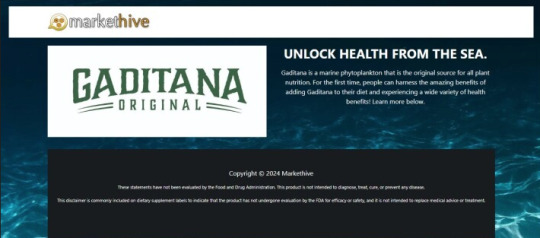
Image: One example of the forthcoming landing pages for Gatitana Source: Markethive
The Power of Collaboration: A New Era in Health Marketing
The collaboration between Markethiive and Blugenics has enabled Gaditana Original to expand its reach and ship to four significant countries, including the United States, Canada, Mexico, Australia, and the Bahama Islands. More countries will soon open to help more people worldwide.
This development brings a unique opportunity for people worldwide to experience the benefits of this ancient, original base food. Ironically, after centuries of being overlooked, it's only now that this plant is being recognized for its true value and offered in its pure form, marking a significant moment in history.
Gaditana Original is a truly unique product, and we're excited to introduce you to the exceptional platform that will help us share it with the world. Meet Markethive, a cutting-edge marketing powerhouse. Our comprehensive suite of tools encompasses a wide range of efficient customer and distributor acquisition methods, including capture pages, email marketing, social media, broadcasting autoresponders, press release platforms, viral blogging systems, and many more innovative solutions. These resources equip entrepreneurs with diverse tools to amplify their business growth and reach new heights.
The Markethive team is currently building the group blogs, autoresponders, and capture pages for everyone to use that will all be coded to the individual group members. Leveraging the power of blockchain technology, these tools work in harmony to maximize their effectiveness, resulting in a powerful synergy that amplifies your team's success as the number of distributors grows.
By joining the Blugenics Customer Acquisition Group within Markethive, you're not just becoming part of a team but gaining access to a wealth of resources and support. Our systems are already built for you and are ready to help you and your teams start making progress immediately. We're here to support your journey to success, providing you with the tools and guidance you need to thrive.
This partnership between Markethive, the premier marketing platform, and Blugenics, the ultimate superfood, creates a powerful synergy – a match made in heaven. If you're ready to enhance your capabilities and empower yourself, we cordially invite you to join us. Your journey to success starts here ⤠https://markethive.com/group/customeracquisition


Editor and Chief Markethive: Deb Williams. (Australia) I thrive on progress and champion freedom of speech. I embrace "Change" with a passion, and my purpose in life is to enlighten people to accept and move forward with enthusiasm. Find me at my Markethive Profile Page | My Twitter Account | and my LinkedIn Profile.
0 notes
Photo

New Post has been published on https://cryptonewsuniverse.com/from-financial-to-physical-the-next-big-thing-in-crypto-depin/
From Financial To Physical The Next Big Thing In Crypto - DePIN


From Financial To Physical. The Next Big Thing In Crypto – DePIN
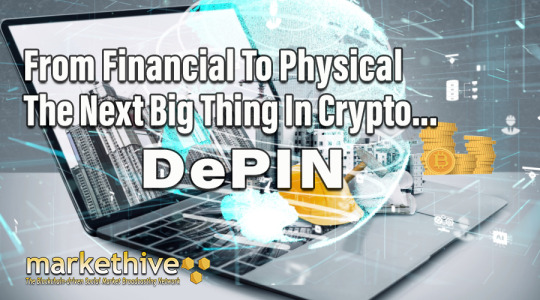
Recently, there has been significant interest in decentralized physical infrastructure, also known as DePIN, within the crypto space. People are curious about the potential of this niche and which specific projects within it are worth noting. The latest detailed study, titled State of DePIN 2023 by Messari, aims to provide insights into these questions. This summary will highlight key findings from the report and discuss their potential impact on the cryptocurrency market.
What Is DePIN?
The report commences with a concise delineation of DePIN, an acronym for decentralized physical infrastructure. It encompasses a cluster of ventures that employ cryptocurrency-based incentives to foster a range of physical infrastructure. These initiatives span from decentralized Wi-Fi systems, decentralized computing clouds, decentralized cloud storage solutions, and decentralized mobile networks to other similar endeavors. A salient feature that sets most DePIN projects apart, in addition to their crypto-based incentives, is the accessibility for individuals to contribute, provided they possess the requisite hardware.
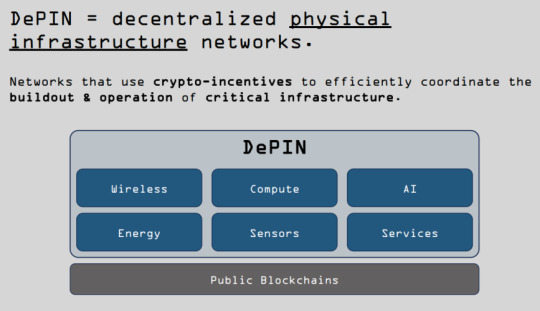
Source: The Messari Report.pdf
The report highlights that DePIN solutions have the advantage of being more efficient, resilient, and high-performing than their centralized counterparts. Additionally, DePIN projects can rapidly innovate and evolve due to community participation, which gives them a unique edge over centralized projects. This efficiency and resilience not only make them attractive to investors but also instill confidence in their long-term viability.

Source: The Messari Report.pdf
The authors posit that DePIN initiatives possess a self-reinforcing mechanism known as a flywheel, whereby their growth and influence fuel further adoption and expansion. As these projects gain traction and popularity among users and service providers, they become even more potent and widespread, creating a positive feedback loop. The authors project that DePIN will substantially impact the global economy, with the potential to augment GDP by a staggering $10 trillion over the next decade. This ambitious projection underscores the transformative potential of these projects.

Source: The Messari Report.pdf
The authors go on to list the industries in which DePIN is currently causing significant changes. These industries encompass various areas such as digital maps in the crypto sector, energy grid management, home internet services, food delivery platforms, ride-sharing services, and, surprisingly, even pet and livestock-related projects. It should be noted that these endeavors are still in their initial phases.
The authors have categorized crypto projects in the DePIN niche into six categories: compute, wireless, energy, AI, services, and sensors. According to their analysis, there are over 650 cryptos across these categories, with a combined market capitalization of over $20 billion.
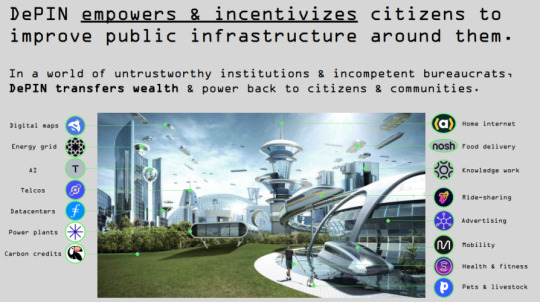
Source: The Messari Report.pdf
The DePIN projects have garnered significant interest from venture capitalists, resulting in substantial capital being invested. To put it in perspective, the top ten DePIN projects alone have collectively secured a significant amount of funding. It's worth noting that many of these projects continue to attract investments even after their initial coin offerings (ICOs) and the launch of their main networks.
It is uncommon for a crypto project to secure substantial funding after its ICO. However, when this does happen, it indicates that investors have tremendous confidence in the project's potential. The DePIN niche has attracted significant post-ICO funding, with numerous projects raising substantial amounts. The top ten DePIN crypto projects in terms of funding raised include Filecoin and Helium, each securing $250 million, RNDR Network with $100 million, Fetch AI with $75 million, Livepeer with $50 million, Really with $35 million, Hivemapper with $25 million, Andrena with $25 million, Braintrust with $25 million, and DIMO with $20 million.
DePIN Blockchains
Intriguingly, most of the nearly thousand crypto projects operating within the DePIN space are opting to deploy on a select few cryptocurrency blockchains. This observation encompasses both layer one and layer two blockchains, with Solana emerging as the most favored layer one choice among DePIN projects.
The authors cite the high speed, affordability, and use of the Rust programming language as reasons for this. Among layer two solutions, Caldera and Eclipse are favored for DePIN projects. These platforms offer flexibility, enabling DePIN projects to blend Ethereum's security with Solana's performance, as seen in the case of Eclipse.
In addition to layer one blockchains that prioritize DePIN, the authors highlight some notable examples. Iotex is one such example, which was already utilized by the US military for health monitoring trials in November 2021. Peaq, on the other hand, is still in the pre-launch phase, but it has already generated significant interest and excitement within the community.
The importance of DePIN adoption cannot be overstated, as it will have a profound impact on both layer one and layer two. The success of DePIN chains and projects hinges on the demand side of the equation, which is carefully examined in the second part of the report.
Unlike many other cryptocurrencies, the authors emphasize that DePIN revenues are fueled by utility rather than speculation. They highlight that participants in DePIN projects typically need to purchase and lock or burn their associated tokens in return for access to the decentralized service or product being provided. This characteristic aligns DePIN projects with traditional crypto coins, which are utilized for various purposes, such as payment of fees and staking.
According to the authors, DePIN projects consistently yield an estimated $15 million in yearly on-chain revenue throughout the bear market. Given the large number of DePIN projects, this amount may seem insignificant. The authors, however, need to offer a clear answer to which DePIN projects are the most profitable, leaving it open to speculation.
However, it is worth mentioning that Livepeer has developed a dashboard named the Web 3 Index, which monitors the earnings of major DePIN projects. Decentralized storage and computing are generating the highest revenue.
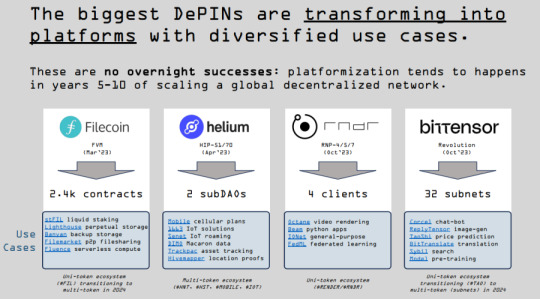
Source: The Messari Report.pdf
The authors highlight the evolution of DePIN projects, with many expanding their offerings to become comprehensive platforms providing a variety of decentralized products and services. They cite Filecoin, Helium, RNDR Network, and Bittensor as five notable examples of such platforms, demonstrating the diversification of DePIN projects beyond their initial scope.
DePIN Categories
Compute
In the next section, the authors divide the Compute category into its previously discussed main elements: Storage, Compute, and Retrieval. They mention that specific DePIN projects within the compute category, such as Filecoin and Akash Network, provide a “full stack experience.”

Source: The Messari Report.pdf
In terms of Storage, it's suggested that DePIN could gain widespread acceptance by utilizing decentralized data storage. While other cryptocurrency projects and protocols have primarily adopted this technology, it's promising to see increased decentralization across the crypto space. This article provides an opportunity to delve deeper into the meaning of decentralization.
The authors highlight that Compute faces the opposite issue compared to storage. While there is an abundance of decentralized data storage but insufficient demand for it, the supply of decentralized computing power is lacking. Yet, there is a surplus of demand for it.
The authors note that decentralizing Retrieval poses a significant challenge, especially in maintaining competitiveness. This is primarily due to the fact that Cloudflare, a centralized retrieval protocol, currently serves 20% of all regular websites at no cost, making it challenging to monetize alternative solutions.
Wireless
This relates to the next DePIN category the authors detailed earlier: Wireless. The growth of the total addressable market for decentralized wireless services has been exponential, and it's no surprise why. The demand for decentralized wireless services is rising as the world becomes increasingly interconnected. This category of DePIN has even earned its own name – DeWi, short for decentralized wireless – highlighting its significance in the industry.
The authors also divide this category into three parts: mobile, fixed internet, and Wi-Fi. Helium, in particular, is gaining significant attention due to its rapid expansion and popularity. As an illustration, Helium has collaborated with T-Mobile to offer affordable mobile plans across the US.

Source: The Messari Report.pdf
Data Sales
The authors decided to examine a new category not initially included in their list but gaining significant interest: Data sales. They point out the importance of data in a world that is becoming more digital.
That is why they are optimistic about DePIN initiatives such as Hivemapper, which motivates individuals to map their local surroundings, similar to Google Maps but without a central authority. They also highlight other specialized DePIN projects, such as one that monitors noise pollution in a community-driven manner.
This relates to another category detailed earlier: Services. According to their perspective, they classify services into two types: horizontal services, like decentralized marketplaces for freelance work, and vertical services, such as decentralized ride-sharing systems.
The conversation shifts to the emerging DePIN category of Vertical Ads, but surprisingly, they don't offer much insight into it. Notably, they fail to mention the Brave browser in this context. The situation is similar regarding energy-related DePIN initiatives, as they are also in the early stages of development.
DePIN Growth, Potential
The report now shifts its attention to the supply side of the equation, specifically examining the remarkable growth and potential of DePIN nodes. The authors begin by presenting an interesting fact: The number of DePIN nodes continues to grow and has now surpassed 600,000. The graph below illustrates that the Wi-Fi map nodes are the most numerous, with more than 200,000 nodes being a part of the DePIN project.

Source: The Messari Report.pdf
The authors note a rapid increase in the quantity of DePIN nodes. This growth is attributed to DePIN initiatives addressing scalability challenges related to the expansion of physical infrastructure. Consequently, DePIN offerings are becoming more affordable and of higher quality. It is worth noting that the development of this physical infrastructure is being encouraged through the distribution of crypto incentives, particularly tokens awarded to individuals contributing to such infrastructure.
The tokenomics of these tokens are integral to the supply-side equation, and the authors recognize three distinct strategies. First, supply-based tokenomics encourages growth. Second, demand-based tokenomics promotes efficiency. Lastly, a combination of supply- and demand-based tokenomics strikes a balance between development and efficiency.
The advantages and disadvantages of the three methods are outlined in the image below. The authors also observe that certain strategies have been more effective for specific DePIN projects. For example, they note that projects that require a lot of hardware benefit the most from supply-based tokenomics, as it essentially rewards contributors with a large number of tokens. On the other hand, DePIN projects that are primarily software-based can expand by offering points that may eventually be converted into tokens.

Source: The Messari Report.pdf
In assessing the value of various DePIN projects, the authors recommend focusing on both the market cap and the fully diluted valuation. Their rationale is that DePIN projects often involve significant investments from venture capitalists, which can influence price movements.
Essentially, the authors suggest that the demand for specific DePIN offerings may be tempered by the influx of tokens from initial project backers. They imply that lower-quality DePIN projects may encounter challenges and predict that many early investors will opt to sell once their portfolios have appreciated five to tenfold.
Before making any investment decisions, it's crucial to thoroughly investigate cryptocurrencies, especially those in emerging sectors like DePIN. While some experts recommend investing in blockchains that support DePIN projects to mitigate risk, this approach may not yield returns as substantial as identifying and investing in promising DePIN projects early on, with their potential for 100x growth.
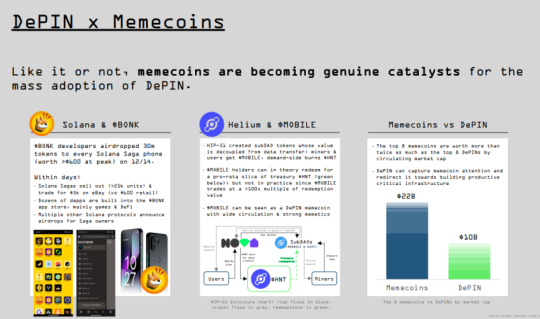
Source: The Messari Report.pdf
DePIN 2024 Forecast
The section of Messari's DePIN report that garnered the most excitement is the predictions for DePIN in 2024. According to the authors, the first theme you need to watch out for is the intersection of DePIN and AI, which is expected to play a crucial role in DePIN's development. DePIN AI has the potential to surpass centralized AI in terms of capabilities and effectiveness within the next one to two years.
The second important topic is the intersection between DePIN and meme coins. While the idea may seem odd, the authors acknowledge this and use the Solana phone Bonk airdrop as an example to show how these two can be paired. This also hints at a future where physical infrastructure is encouraged through the use of meme coins.
The third important aspect to be mindful of is the intersection of DePIN with zero-knowledge technology. By leveraging advanced zero-knowledge technology, DePIN could carry out a form of cyber attack known as a vampire attack on Web 2, which involves taking control of users' content and activity.
The fourth theme to watch is similar to the third but focuses on the intersection between DePIN and gaming. Think of it as GameFi on steroids, where the cryptocurrency elements of gaming are integrated with cutting-edge gaming technology, such as VR headsets, to create a more immersive and interactive experience.
The fifth theme to be mindful of is the intersection between DePIN and privacy, with a particular focus on decentralized virtual private networks (VPNs) as a critical intersection area.
The authors highlight a curious trend in DePIN: The intersection between DePIN and Asia, referring to the continent, is expected to yield unexpected results. They foresee multiple top 10 DePIN projects emerging from this region, with most still in the nascent stages of development.
What It Means For Crypto
The DePIN report's findings have significant implications for the cryptocurrency market. In essence, they suggest that the most successful cryptocurrency narratives and niches during the current bull market will be those that are not financially focused. A previous article on crypto narratives supports this and is reinforced by the fact that some DePIN projects have already acknowledged this trend.
Several crypto initiatives acknowledge that applications related to finance will face increased scrutiny. In contrast, DePIN presents a significantly lower likelihood of antagonizing regulators, and its credibility is evident. The increasing presence of DePIN projects on global app stores and their partnerships with established companies and brands demonstrate that it operates within a safer realm, particularly in regulatory compliance.
Given its immense potential and the nascent stage of most DePIN projects, the DePIN niche is expected to be highly unpredictable from an investment standpoint. While some tokens may experience astronomical growth, others will likely plummet in value or become worthless. Despite the risks, the long-term outlook for DePIN indicates that it will have a lasting impact on the cryptocurrency landscape, contributing to increased adoption and mainstream acceptance.
Previously, the main factors driving cryptocurrency demand were primarily based on speculation. However, real-world adoption may occur with the rise of DePin and other non-financial sectors. This shift could make everyday individuals feel more at ease using and putting money into cryptocurrency, consequently boosting further adoption and investment. Advocates believe that the ultimate goal of cryptocurrency is to decentralize all aspects of life. If that is the desired outcome, we are on the right path.
The reaction of centralized equivalents to the decentralized alternatives of popular products and services is a topic of much speculation. Some anticipate a similar response to DeFi and other disruptors of the traditional financial system, characterized by intense regulatory opposition, mainstream media-fueled FUD, and attempts to suppress their growth. However, DePIN networks have an inherent advantage that will make them more resistant to suppression, as they are generally more decentralized than most cryptocurrencies. This resilience will demonstrate the staying power of crypto.
This article is provided for informational purposes only. It is not offered or intended to be used as legal, tax, investment, financial, or other advice.


Editor and Chief Markethive: Deb Williams. (Australia) I thrive on progress and champion freedom of speech. I embrace "Change" with a passion, and my purpose in life is to enlighten people to accept and move forward with enthusiasm. Find me at my Markethive Profile Page | My Twitter Account | and my LinkedIn Profile.
0 notes
Photo
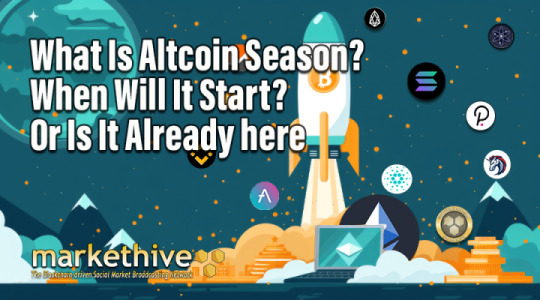
New Post has been published on https://cryptonewsuniverse.com/what-is-altcoin-season-when-will-it-start-or-is-it-already-here/
What Is Altcoin Season? When Will It Start? Or Is It Already Here?


What Is Altcoin Season? When Will It Start? Or Is It Already Here?
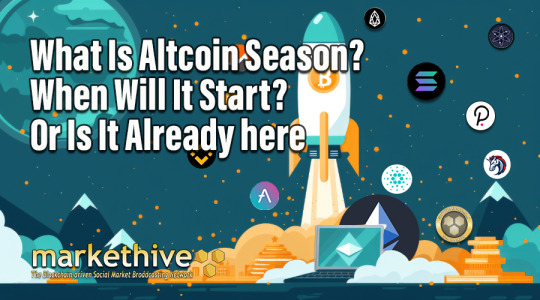
Altcoin season, a term on the lips of many cryptocurrency enthusiasts since Bitcoin's recent surge to unprecedented heights, is a phenomenon many have eagerly anticipated. However, despite this anticipation, only a select few coins and tokens, along with many meme coins, have experienced substantial growth. This has led to speculation that altcoin season may never arrive, as funds flowing into spot Bitcoin ETFs may not be redirected towards the broader cryptocurrency market. But is this the full story?
With the invaluable insights of some highly credible crypto experts, this article takes a deep dive into the current state of the cryptocurrency market. It focuses on the 'altcoin season' concept and its potential impact on market trends. The article explores why altcoin season has yet to occur and predicts when it may begin. It also offers insights on how to recognize its onset. Additionally, the article highlights the types of alternative cryptocurrencies (altcoins) that may be worth watching during this period.
The Concept of Altcoin Season
Firstly, let's touch on the concept of altcoin season, a term that lacks a universally accepted definition. Some assume it refers to a period where numerous altcoins are experiencing a surge in value, with many believing that it's already underway. Given the recent performance of certain altcoins, one could argue that it's already here. However, this definition falls short of accurately capturing the concept, so here’s a more precise and nuanced explanation.
An altcoin season is an extended timeframe during which most alternative coins exhibit notable outperformance compared to Bitcoin. This can be gauged by analyzing the price of an altcoin with Bitcoin, for example, ETH/BTC. When assessing the BTC pair for various altcoins, it becomes evident that their performance has not been particularly strong. However, this does not imply that they have not experienced price increases in fiat currency; rather, it indicates that their gains have been comparatively lower when measured against Bitcoin.
The current situation with ETH and BTC is a significant development in the cryptocurrency market. ETH's value has decreased compared to BTC, which has raised concerns among traders and investors. Historically, increases in BTC's value have often been followed by a shift in investments towards alternative cryptocurrencies, leading to a period where most altcoins perform better than BTC.

Source: Coinmarketcap
In the past, the trend has been to invest in ETH and then move on to other major alternative cryptocurrencies, followed by mid-cap and small-cap altcoins. It is important to note that this progression is not always precise but generally aligns with the idea that investors gravitate towards more speculative crypto assets as market momentum continues. Interestingly, in the current scenario, there has been limited shifting of funds into ETH, as indicated by the underperformance of the ETH/BTC pair mentioned earlier.
Furthermore, it appears that the influx of capital did not favor midcaps and small-caps but instead directed attention towards micro-cap meme coins for speculative purposes. It is important to note that while certain altcoins like Solana's SOL have shown impressive performance compared to BTC, most altcoins, including ETH, have not surpassed BTC's growth. This suggests that the altcoin season may have yet to arrive fully.
As indicated earlier, cryptocurrencies with smaller market capitalizations tend to be riskier. This is because crypto with a smaller market cap has the potential to experience more significant and rapid price increases compared to those with larger market caps. However, on the flip side, small-cap cryptocurrencies are also prone to more substantial drops in value, highlighting the risk/reward ratio.
The notable 100x returns often associated with certain altcoins are typically achievable with those that have smaller market caps, explaining the hype around the altcoin season. Nevertheless, there are indications that the current cryptocurrency market cycle differs from previous ones, which could have significant implications for the returns on altcoins.
The Question on Everyone's Mind: When Will Altcoin Season Arrive?
Many wonder why the current market cycle hasn't followed the same pattern as previous ones, with altcoins yet to take center stage. To understand this, we must first acknowledge the unique factor setting this cycle apart: spot Bitcoin ETFs. As discussed earlier, some believe these ETFs are hindering the rotation into altcoins, as investors cannot easily switch from ETFs to altcoins, at least in theory. However, some investors may be cashing out their ETF gains and moving their funds to cryptocurrency exchanges like Coinbase, where they can invest in altcoins.
The catch is that most investors in spot Bitcoin ETFs are not your average retail investors but seasoned institutional investors. These institutional investors, also known as TradFi whales, have a significant influence on the market. As a result, their preferences for alternative cryptocurrencies may diverge from those of the typical crypto enthusiast. Notably, there has been substantial institutional interest in SOL, which could explain its outperformance compared to BTC.
However, the crypto market is not solely composed of institutional investors. There are two other types of crypto investors: crypto whales and retail investors. Crypto whales, which are large holders of cryptocurrencies, have been the primary influencers in the crypto market so far. Their shift from Bitcoin to alternative coins has led to past cycles in altcoins, while retail investors have pushed these coins to their peak values. Put simply, the crypto market has not lost anything. It has merely introduced a new main character, figuratively speaking.
The lack of an alt season is not caused by the introduction of ETFs but rather by the actions of crypto whales and retail investors. The analysts at Coinbureau suggest that these crypto whales are not shifting their investments or rotating into altcoins because there currently needs to be more retail investors interested in purchasing them.

Source: Crypto Max on X
Numerous indicators suggest that retail investors are gradually becoming more interested in cryptocurrency despite their limited participation in the current market upswing. This is evidenced by increased retail trading activity on cryptocurrency exchanges, the growing popularity of crypto exchange apps, rising search volumes for crypto-related terms, and heightened social media engagement with crypto content. However, these metrics have not reached the levels indicating a massive influx of new retail investors into the cryptocurrency market.
The crucial factor here is the influx of new retail investors. While millions of retail investors from previous cycles are still active or returning, we need to see more new entrants into the market. This is a significant concern, as altcoins rely heavily on new investors to drive their growth and create upward momentum. As a retail investor, you can influence the altcoin season. There need to be marginal buyers.
As Coinbureau states, “We need new people for our altcoin bags to pump, probably because most of us have already allocated as much as we can to our favorite coins and tokens. In the absence of these new people, there's not that much for us to do except speculate on memecoins, and it's quite possible that the memecoin pumps we've seen have been coordinated by the crypto whales. They probably know that the only retail investors around right now are experienced enough to use DEXs.”
The Onset of Altcoin Season
After analyzing the delay in the arrival of altcoin season, the next question is when we can expect it to begin. The straightforward answer is that it will start when a sufficient number of retail investors take notice. This will prompt crypto whales to shift their focus from Bitcoin to altcoins that retail investors will then eagerly buy into, leading to a chain reaction of FOMO (fear of missing out). However, a more in-depth analysis, which necessitates a look back at the previous cycle, reveals a more intricate scenario. Most of us envision the upcoming altcoin season as a repeat of the last cycle, but the reality may be more complex.
The issue lies in the significant differences observed in the previous cycle. Due to a worldwide pandemic, billions of individuals were confined to their homes while a few hundred million received a stimulus payment, providing them additional funds. These events led to widespread speculation in both stocks and cryptocurrencies. Today, the situation is starkly contrasted as interest rates across various nations are at their highest levels in years. Unofficial inflation rates are soaring in most countries, reaching double digits. Several countries are experiencing or nearing recession.
Above all, most individuals are reportedly accumulating unprecedented levels of debt to maintain their standard of living. This trend starkly contrasts with the circumstances observed during the previous alt season. A positive aspect is that the prolonged persistence of these conditions may prompt governments and central banks to provide comparable forms of economic support, never mind the possibility of an existential shock.
This means that there will likely come a time when economic conditions mirror those seen during the pandemic, with similar fiscal and monetary support levels. The exact timing is uncertain, but it may take a significant event to prompt such action. Identical to past patterns, this could cause a brief decline in cryptocurrency and other asset values, followed by a stabilization period and a sharp price increase as the stimulus takes effect.
If the current state of the market persists, altcoins may suffer under unfavorable circumstances. If trends continue, including high interest rates, rising inflation, recurring recessions, and mounting retail debt, the subsequent altcoin season may fall short of expectations. It's essential to recognize that the cryptocurrency market has undergone significant changes since the previous cycle, with factors beyond spot Bitcoin ETFs contributing to its evolution.
Regulations in the US, UK, and other countries have made it more difficult for retail investors to reach offshore trading platforms where highly speculative altcoins are traded. The upcoming EU stablecoins regulations are anticipated to impact the cryptocurrency market significantly. It has been announced that USD stablecoins will no longer be allowed in the EU by the end of the year, potentially reducing the options for retail investors to trade cryptocurrencies.
Identifying the Arrival of Altcoin Season
To determine the onset of the altcoin season, keep a close eye on several key indicators. These include retail trading volume, the popularity of crypto exchange apps, Google searches, and social media views related to cryptocurrency. When you observe a steady increase in these metrics, alt season is likely imminent. Interestingly, there are signs that this trend may already be underway. For instance, search queries related to buying cryptocurrency have started to rise after years of stagnation, although they still have a long way to go before reaching their previous peak.

Source: Google Trends
The current market dynamics are making it challenging to determine whether we are witnessing the inception of a new alt season or a fleeting speculative surge. A valuable approach to shed light on this puzzle is examining how cryptocurrency projects promote themselves, specifically during periods of heightened attention. A typical pattern among cryptocurrency projects is to unveil significant announcements when public interest is at its peak.
There have been instances where crypto projects have postponed significant updates and announcements due to a lack of interest from retail investors. Despite this, numerous crypto projects have been making notable announcements, which could suggest the beginning of a new altcoin season. However, these announcements have not resulted in significant speculative buying, indicating that retail investors remain scarce.

Source: CoinMarketCal
As the popularity of cryptocurrency projects grows, you may notice a surge in big announcements and subsequent price increases for their coins or tokens. This is often a sign that retail investors have entered the market. When these altcoin announcements start making headlines in mainstream news, it could indicate that the market is nearing its peak.
Some of you have probably encountered additional key indicators, like inquiries from friends and family regarding the crypto market or, worse, seeking advice on investing in meme coins. However, these signals may not hold much weight unless individuals actively invest. Suppose widespread media coverage of altcoins is not leading to a substantial market increase, and your acquaintances are not showing significant interest. In that case, it may not truly be an alt season.
A possible indicator of an impending alt season is to evaluate whether these signs are present when, based on historical patterns, an altcoin season would be expected to occur from a cycle perspective. However, this can be difficult to determine as the introduction of spot Bitcoin ETFs has disrupted the typical cycle. For reference, the current phase of the cycle should resemble the early 2020 period, characterized by gradually increasing prices followed by a sudden crash triggered by an unexpected event before ultimately continuing their upward trend.
It's worth considering that our timeline may be advancing at an accelerated pace. Specifically, we could be closer to the late 2020 stage of the crypto market cycle, irrespective of the introduction of Bitcoin ETFs. With two completed crypto cycles (2017 and 2021) under their belts, millions of individuals are now familiar with the narrative and its subsequent developments.

Source: Bitcoin News on X
The impact is that we won't have to wait 12 months for the altcoin season to begin like we did in 2020. Instead, it could start in just a few months. However, this is based on the assumption that we're on an accelerated timeline. It's possible that cryptocurrency is still following the same schedule, which means we might be ahead of schedule for alt season.
Which Altcoins Should Be Monitored
Which altcoins should you watch this season? I concur with Coinbureau that it might be ideal to start building up your portfolio if we are in the early stages of the altcoin season. However, it's essential to note that this is not financial advice, and it's equally possible it's not the best time to do so.
Coinbureau analysts suggest that the altcoins you must watch this season will be the most accessible to retail investors. As mentioned earlier, EU regulations and, consequently, the structure of the crypto market will ensure that most retail investing will take place on onshore exchanges like Coinbase. In light of this potential scenario, focusing on altcoins listed on Coinbase may be prudent.
This is connected to a previous point about market capitalization. The higher the market cap, the lower the risk and the potential reward. The smaller the market cap, the bigger the risk, but the bigger the reward. Selecting a cryptocurrency with a lower price tag may also be advantageous. Many individual investors assume that a lower price indicates the possibility of more significant price increases, but the market cap is the most important. Therefore, by choosing a low price and market cap cryptocurrency, you can establish some solid fundamentals, often referred to by some influencers as "pumpamentals."
While being listed on Coinbase and having a low price point and market capitalization can benefit an altcoin, more is needed to guarantee success. For an altcoin to truly thrive, it must fit into a broader, bullish narrative that resonates with the average retail investor. This article explores the dominant narratives likely to drive the next bull market.

Image: Markethive.com
Researching the tokenomics of the crypto you want to invest in is vital to ensure it is genuine and has maximum potential. This involves examining the future circulation of coins or tokens, as you wouldn't want to invest in a promising altcoin only to face a sudden sell-off by the developers and their venture capital supporters. Also, you need to select a smart contract cryptocurrency on which the most promising tokens are trading.
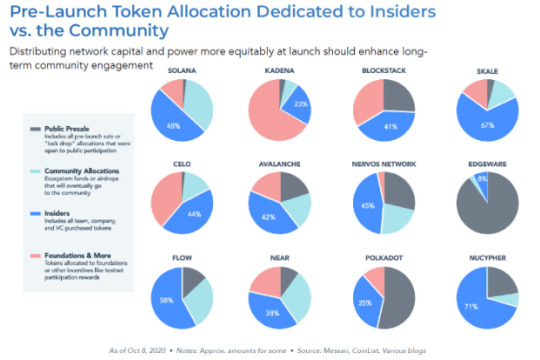
Image: Cointelegraph
It is essential to understand that holding onto a promising altcoin for a longer term could be beneficial if you enter the market at the right time. Numerous cryptocurrency enthusiasts can confirm that they would have been equally successful today if they had kept their altcoins during the market downturn. Cryptocurrency, at its core, is designed to revolutionize various systems, so it's important to have a long-term perspective on your investments.
Although many of these systems and their associated projects may fail, a few will endure. The ones that survive have the potential to become extremely valuable, possibly even worth trillions of dollars in the future, much like Bitcoin, which is currently valued at over $1 trillion. It is crucial to note that BTC boasts the lengthiest and most proven track record among all coins and tokens, rendering it the most secure cryptocurrency to retain in comparison.
Other cryptos will more than likely someday achieve the same safe haven status as BTC, so considering all the key indicators along with a crypto’s community, utility and purpose, ecosystem, and solutions it offers in the spectrum, it shouldn’t be too hard to work out which ones to watch out for. For that large-cap security, you might want to consider investing in the original cryptocurrency that has the potential to become the global reserve currency.
This article is provided for informational purposes only. It is not offered or intended to be used as legal, tax, investment, financial, or other advice.


Editor and Chief Markethive: Deb Williams. (Australia) I thrive on progress and champion freedom of speech. I embrace "Change" with a passion, and my purpose in life is to enlighten people to accept and move forward with enthusiasm. Find me at my Markethive Profile Page | My Twitter Account | and my LinkedIn Profile.
0 notes
Photo

New Post has been published on https://cryptonewsuniverse.com/the-financial-system-is-contrived-to-its-core-the-truth-is-out-and-you-need-to-know/
The Financial System Is Contrived To Its Core The Truth Is Out And You Need To Know


The Financial System Is Contrived To Its Core. The Truth Is Out, And You Need To Know

Many individuals struggle to keep pace with the increasing cost of living, primarily influenced by a financial system not operating fairly. Or, to put it bluntly, the economic system is rigged. Corporations, governments, and those in positions of authority face immense amounts of debt in the trillions that cannot realistically be repaid. Their choices are either to default and face severe consequences or to reduce the value of this debt through inflation and manage it through regulations. Unfortunately, they have opted for the latter, to the detriment of the collective society.
This article exposes the financial system's flaws, highlighting three key factors contributing to its dysfunctional state. First, a disconnect between money and currency leads to a distorted view of their true value. Second, the time value of money is manipulated, creating an unfair advantage for specific individuals and institutions. Lastly, the ease of access to credit in a credit-driven economy has created an unsustainable cycle of borrowing and debt. These factors combined have rigged the financial system, creating an unequal playing field for all participants.
The article also sheds light on the reasons behind your struggle to keep up with the increasing cost of living and offers practical tips on adapting and staying ahead of the game despite these challenges.
1: The Disconnect Between Money and Currency
In today's world, currency and money possess distinct characteristics, though often used interchangeably. In essence, money represents a store of value, maintaining its worth over time. On the other hand, Currency does not retain its value, depreciating with time. One prime example of money is gold, acknowledged as a valuable store of wealth for centuries.
The value of gold has remained consistent over time, making it an excellent store of value. When pricing assets like houses and cars in gold terms, their prices have remained relatively stable in recent decades. However, when pricing them in currency terms, their prices have increased dramatically in recent years.

Source: Boomerang Capital Partners
In the past, money and currency were synonymous, with currencies representing money. For instance, the US dollar was once backed by gold, and other global currencies were tied to its value. This system ensured that receiving payment in a currency meant receiving something that maintained its worth over time.
However, in 1971, a significant shift occurred when President Richard Nixon decided to “temporarily suspend” the conversion of US dollars to gold. This move allowed governments and central banks to increase the money supply without being constrained by the need to back it with gold reserves. As a result, the supply of US dollars has grown exponentially since the 1970s, as illustrated in the chart below.

Source: Reddit
According to fundamental economic principles, the greater the quantity of a commodity, the lower its worth. Hence, the rising prices of items such as houses and cars are not due to increased value. Instead, a decrease in the value of currencies is driving this trend. The rise in the amount of currency in circulation is known as inflation, and we are often led to think of it as beneficial for both individuals and the economy. This is because inflation encourages spending.
Individuals tend to increase their spending when the value of their currency is depreciating, which, in theory, can stimulate economic expansion and prosperity. However, in practice, inflation harms the ability to preserve currency value, incentivizing overconsumption. Moreover, official inflation measurements have been underestimating the actual inflation rate for years.
The primary issue with the disconnect between currency and money is that individuals continue to receive their income in currency rather than actual money. To make matters worse, people are being misled into believing that the currency they receive has the same value as it did in the past, with the notion that it's equivalent to gold.
The persistent inflation is why it's challenging to maintain a decent standard of living and achieve financial stability. Your earnings are declining in value while you're attempting to purchase goods that are actually valuable, such as real estate or vehicles. This paradox between money and currency may leave you questioning why currencies have any value at all in today's world.
The answer is basically because the government says so. That's why currency is now more often referred to as fiat currency. The Latin word “fiat” translates to “let it be done”. The English dictionary definition of fiat is “an arbitrary order or decree.” However, this is only one aspect contributing to the perception that the financial system is rigged.
2: The Manipulation Of The Time Value Of Money. (TVM)
The second factor involves the manipulation of the time value of money (TVM). In this context, the time value represents the cost of borrowing money over a specific timeframe. Typically, the interest rate increases as the borrowing period extends. This is because the lender foregoes potential opportunities that could have been pursued with the loaned money during that time.
For instance, imagine you need to borrow money for a decade. Lenders might be willing to lend it to you if you agree to pay them a 50% premium at the end of the ten years. This is because ten years is a significant amount of time, and they could have earned a comparable return by investing their money elsewhere.
However, suppose you're looking to borrow money for a short period, precisely one year. In that case, lenders might be more willing to approve your request if you agree to pay an additional 5% interest at the end of the term. This is because one year is considered a relatively short time frame. While they could have potentially earned more interest by investing the money elsewhere, it's often more straightforward and less risky for them to just grant the loan.

Source: Investopedia
Combining all these loans and their individual interest rates on a graph would result in what is known as the yield curve, a line that inclines upward and to the right. Essentially, the yield curve indicates that the longer the duration of the loan, the greater the interest rate that must be paid. This is where the situation can become somewhat intricate;
If you're looking to borrow a substantial amount of money for an extended period, you may encounter lenders who require a higher interest rate due to the increased risk involved. For instance, if you want to borrow $1 billion for ten years, lenders might demand an additional 100% interest on top of the initial amount, effectively doubling the total amount you'd need to repay. This is because providing such a significant loan over an extended period involves opportunity costs and entails considerable risks, with the primary concern being the possibility of defaulting on the repayment.
Lenders typically charge a higher interest rate to offset the risk of lending. The yield curve may be steeper and begin at a higher percentage based on the loan amount under normal circumstances. However, in today's market, borrowing for a short period can be more expensive, and some larger loans may have lower interest rates than smaller loans with similar repayment terms.
It may seem surprising, but the primary reason for this is largely attributed to central banks. Typically, loan interest rates are influenced by the balance between the availability of lending and the desire for borrowing. When there is a high demand for loans and a limited supply, interest rates tend to be high, and conversely. However, central banks can manipulate interest rates manually, disrupting the natural market dynamic.
The caveat is that they can manually set the interest rates on shorter debt durations. Before the 2008 financial crisis, this was the only action they took. In response to the 2008 crisis, central banks took the unprecedented step of manipulating longer-term interest rates for the first time in modern history. They did this by buying long-term government debt, which lowered interest rates for similar debt durations.
Until the 2008 financial crisis, central banks only controlled short-term interest rates. They could manually set the interest rates on shorter debt durations. However, in response to the crisis, central banks took the unprecedented step of manipulating longer-term interest rates by purchasing long-term government debt, which lowered interest rates for similar durations of debt. This was a significant departure from their traditional role and marked a new era of monetary policy.
To put it differently, central banks manipulated the time value of money across all time frames, making borrowing cheaper to stimulate economic growth. However, this approach has led to inflation instead of a quicker recovery. By keeping interest rates artificially low, more currency is created out of thin air, not only by governments and central banks but also by individuals and organizations.
As we now know, the value of currency depreciates as its supply increases. Unfortunately, this devaluation has occurred four more times since 2008, thanks to the manipulation of money's time value across all time frames. This has led to higher inflation and continued to make borrowing artificially cheap—but only for those with access to credit.
3: Access To Credit (in a Credit Driven Economy)
In a credit-driven economy, the third factor contributing to the rigged financial system is the disparity in access to credit. The intention behind manipulating the time value of money was to facilitate borrowing for all, thereby promoting economic growth. However, this manipulation had an unintended consequence: instead of making credit more accessible to everyone, it only became easier for select individuals and institutions to borrow, leading to inflation.
These individuals and institutions utilize their funds for various purposes, including acquiring valuable assets such as stocks and real estate. This demand leads to a significant increase in the prices of these assets while the value of the currency used to purchase them depreciates. As a result, the average person can only keep up by borrowing more currency to buy the remaining valuable assets, thereby increasing their prices even further.
Initially, the various green indicators may appear to signify economic expansion due to their upward trends. Yet, upon further examination, it becomes evident that inflated asset prices have mainly fueled this growth due to low-cost borrowing practices implemented since 2008 rather than genuine economic expansion. Consequently, there has been limited actual economic growth during this period.
For instance, the actual economic output in G20 nations has shown minimal growth since 2008, indicating a reliance on credit. Succeeding in this credit-driven economy largely hinges on your capacity to take on increasing amounts of debt, yet this is becoming more challenging.

Source: X
There are various factors at play, which can be categorized into two main groups: formally established financial regulations and informal norms. The Dodd-Frank Act stands out as a significant example of official financial regulation enacted in response to the 2008 financial crisis.
Although lengthy at over 2,000 pages, the Dodd-Frank Act has essentially created challenges for small banks in providing small loans to small businesses and individuals. As a result, small businesses and individuals now face increased difficulty demonstrating their creditworthiness to secure larger loans, while small banks find it harder to function effectively.
Small banks play a significant role as the primary lenders to small businesses. If small banks are unable to provide small loans to these businesses, there will be a decrease in both small banks and small businesses. This could lead to a situation where large banks and shadow banks become the primary sources of funding for small businesses.
Shadow banks, such as Blackrock, have established their own set of rules and regulations that individuals and institutions must adhere to. One example of this is the ESG investment ideology, which has become a powerful tool for manipulating the value of money. Compliance with Blackrock's ESG standards can result in more favorable loan terms, including lower interest rates, while non-compliance may lead to less favorable loan terms.
The rising prominence of Environmental, Social, and Governance (ESG) criteria in financial decision-making is poised to surpass the influence of traditional financial regulations. This shift is expected to gain momentum as ESG considerations become more widespread and affect individual decision-making. Notably, ESG criteria do not originate from the private sector but were introduced by unaccountable and unelected international organizations.
A concerning aspect of the situation is that credit accessibility is now being influenced not only by commercial banks and shadow banks but also by central banks purchasing corporate debt in response to the pandemic flash crash in 2020. Similar to purchasing government debt, buying corporate debt results in decreased interest rates on that debt. The selective nature of central banks' purchases, favoring certain corporations over others, created an unfair advantage for those chosen corporations as they could access credit at even lower rates.
The prevailing sentiment among macro analysts is that the extent of your credit access is directly linked to your financial standing. In other words, individuals or organizations with substantial wealth or size are more likely to enjoy better terms regarding credit, thus perpetuating their advantageous position and facilitating further growth.
Suppose you're struggling financially or running a small organization. In that case, you may find it increasingly difficult to obtain credit in the future unless you conform to the standards set by powerful financial institutions like BlackRock. Even if you manage to secure credit, it will likely come with less favorable terms than those enjoyed by larger entities, further widening the gap between you and them in an economy that relies heavily on credit.
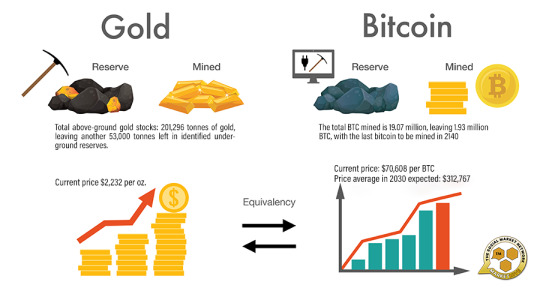
Image by Markethive.com
Maintaining Financial Stability in a Biased Economic System
Our main question is: How can we stay abreast of this rigged financial system? In this unfair financial climate, it's essential to comprehend the mechanisms at play. Let's be clear: this system has little to do with the traditional concept of capitalism. Instead, we're dealing with a system where currency and money have been decoupled by government intervention, in which currency is losing its value. Central banks manipulate the time value of money, and unaccountable and unelected international organizations control credit access, all while insulating from accountability and democratic oversight.
The situation becomes increasingly complex when considering the significant influence of corporations on government decision-making through lobbying efforts, that the commercial banks technically own the central banks, and governments overseeing various unaccountable and unelected international organizations. As previously stated, the financial system is rigged as these entities collectively hold hundreds of trillions of dollars in debts they cannot repay.
The establishment needs currency to decouple from money so that it loses its value. It also needs the time value of money to be low and regulate access to credit, as uncontrolled borrowing could lead to a chain reaction of defaults, jeopardizing its entire system. This is why there is a strong interest in Central Bank Digital Currencies (CBDCs), as they offer the potential to centralize control over the currency.
In light of these details, it's essential to recognize that heavily indebted entities are attempting to manipulate the financial system to avoid defaulting on their debts. They're trying to achieve this by controlling the currency supply and sparking inflation. To illustrate, imagine them filling a swimming pool while simultaneously regulating its size. They’re not trying to drown us or are targeting us per se. These entities are primarily focused on safeguarding their own interests.
Attempting to stay afloat by treading water will eventually lead to drowning. This places the responsibility on us to discover a method to exert less effort and remain buoyant, figuratively speaking. Unfortunately, staying afloat is no easy feat. A simple solution would be to receive payment in money rather than currency, but that's not a realistic expectation. You won't likely find someone willing to pay you in money for long, as it would be too costly for them.
This leaves the other two factors: Unless you work at a central bank, you won't be able to fix the time value of money and bring interest rates back to reality, and if you tried, you could be fired or worse. That's because all those entities can't afford higher interest rates due to their debts, at least on paper. In practice, they can afford these higher interest rates so long as they have access to credit.
Accessing credit can be challenging and restrictive in terms of compliance unless you're a large institution or a wealthy individual. Even if you manage to secure credit, relying on borrowed money to purchase assets may not be a sustainable or effective strategy for achieving financial success.
Analysts suggest that we might be moving towards a time of increased interest rates. In such a scenario, this floating device would become ineffective. This is particularly relevant for individuals who have borrowed money to purchase a property for rental purposes, leverage that property to secure additional loans for more rental properties, and so forth. You are likely acquainted with someone who has engaged in such financial strategies. This method has been a primary means of economic progress since 2008.
If interest rates remain high over an extended period, it may lead to a chain reaction of forced selling, as the cost of servicing debt becomes unsustainable. This downward spiral could cause asset values to plummet, triggering even more sell-offs. In such a scenario, only two factors can help maintain financial stability, and they are closely interconnected.
One strategy is to increase the amount of currency you receive, while another is to invest that currency in assets (money) that maintain value, such as Gold, Bitcoin, or otherwise. The main challenge with the first approach is to increase your income without accumulating excessive debt, preferably none at all. With the growing emphasis on ESG (Environmental, Social, and Governance) considerations, securing financing for a small business may become increasingly difficult without meeting strict compliance requirements.
The biggest challenge with the second issue is that governments may impose restrictions on people's ability to access money as they become more aware of the declining nature of the currency. This could lead to difficulties exchanging money for currency when needed.
As individuals become more aware of the manipulation within the financial system, collective adaptation and progress will be facilitated. This awareness leads to the emergence of economies that value money as a legitimate form of currency once more. It seems inevitable that this shift will occur over time. The likelihood of this transformation happening is high, and there may be truth to the idea of reverting to a gold standard or building a new monetary system backed by Bitcoin, the crypto industry’s gold standard, fitting for this digital age, resulting in a parabolic shift in adoption and value for cryptocurrency, so be sure to be positioned accordingly.
This article is provided for informational purposes only. It is not offered or intended to be used as legal, tax, investment, financial, or other advice.


Editor and Chief Markethive: Deb Williams. (Australia) I thrive on progress and champion freedom of speech. I embrace "Change" with a passion, and my purpose in life is to enlighten people to accept and move forward with enthusiasm. Find me at my Markethive Profile Page | My Twitter Account | and my LinkedIn Profile.
0 notes
Photo

New Post has been published on https://cryptonewsuniverse.com/the-dynamic-crypto-industry-building-a-bitcoin-backed-monetary-system-consider-banks-without-bankers/
The Dynamic Crypto Industry Building A Bitcoin-Backed Monetary System Consider Banks Without Bankers


The Dynamic Crypto Industry Building A Bitcoin-Backed Monetary System. Consider Banks Without Bankers
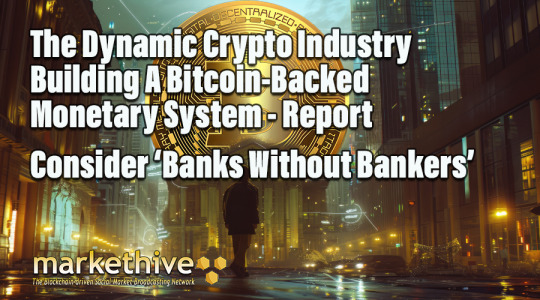
One of the main advantages of cryptocurrency is the independence it offers by enabling individuals to become their own bank. With cryptocurrency, you have complete control and ownership of your assets, whereas traditional banks have technical ownership over the assets you store with them. While the concept of being your own bank is impressive, critics argue that specialized crypto banks may be necessary for crypto to compete effectively with the established financial system.
This article summarizes a report outlining a method for establishing financial institutions without the need for traditional bankers. This method utilizes Bitcoin to achieve this goal, and the approach aligns with the broader aim of revolutionizing the financial sector by harnessing the power of cryptocurrency to replace the existing flawed monetary system.
Banks Without Bankers Prioritizing User Agency
Today's summary is of a report called "Banks without Bankers," released by AxiomBTC, a venture capital firm focused on Bitcoin. The report starts with a powerful quote from Hal Finney, a pioneering Bitcoin developer who received the first Bitcoin transaction. In the quote, Hal Finney envisions a future where BTC is crucial in reshaping the banking system.

Source: Axiom.BTC
In the report authored by Eric Yakes, he explores two potential outcomes for the future of Bitcoin. On one end of the spectrum, all BTC could be held in custody by third parties like banks, with individuals trading receipts instead. This is similar to the historical concept of fiat money, representing a gold claim held by a bank. On the other end of the spectrum, Bitcoin could become a widely-used medium of exchange, with individuals directly transacting with each other and BTC effectively replacing money and its associated functions.
The idea presented is impractical due to several factors. Bitcoin faces limitations in scaling at its core level and is missing the necessary smart contract capabilities for sophisticated financial operations. Similarly, the scenario where all BTC is held in custody is not feasible because some BTC holders prefer to maintain control over their cryptocurrency assets through self-custody and peer-to-peer transactions. Therefore, it can be reasoned that the future of Bitcoin lies in a balance between custody services and individual self-custody practices.
Eric points out in the report that advancing technologies in the Bitcoin sector will allow for striking this balance carefully, emphasizing prioritizing greater peer-to-peer interactions. This approach is logical, as Bitcoin was initially designed to distance itself from traditional financial institutions like banks. In other words, the primary goal of Bitcoin was to remove the reliance on third parties to safeguard assets, hence the inherent trustless quality of cryptocurrency.
Eric contends that not all trust is misplaced, as it's crucial to place confidence in the right individuals and ensure their motivations align. He reinforces this notion by highlighting evolutionary biology findings emphasizing communities' importance in survival and reproduction. He then draws parallels between these findings and the contemporary financial system, where community-oriented banks are less likely to fail.
Eric believes that community banks are restricted by their geographical reach, meaning those nearby can only access their benefits. This limitation stems from the physical constraints of the world. In contrast, the digital realm knows no boundaries or distances. Eric suggests that with the appropriate technology, Bitcoin could enable the establishment of a digital community bank that transcends geographical limitations.
A critical technological component is multi-signature (mult-sig) wallets, which enable multiple individuals to manage a single Bitcoin wallet. In essence, multi-sig wallets enable the creation of conditions that allow this shared wallet to spend BTC. This technology allows the establishment of a ‘federation,’ which Eric defines as a system where “multiple participants hold keys that are useless in isolation, but can be combined to produce a signature that is required to make a transaction.”
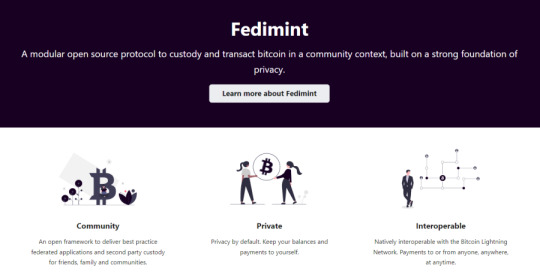
Source: https://fedimint.org/
Fedimint: A Decentralized Solution
The first part of the report introduces a federated network called Fedimint. It’s designed to address issues related to trust in third parties and the complexities of self-custody. The concept is to rely on your community for trust rather than depending on external entities or solely yourself for technical matters of self-custody. A combination of four underlying technologies powers Fedimint;
Federations can be considered a collection of reliable, trusted nodes that work together to operate a network. These nodes are responsible for maintaining the integrity of the system.
Multi-sig wallets, as previously mentioned above.
A privacy-preserving digital currency called eCash which is backed by BTC.
The Lightning Network: (LN) A layer two protocol on the Bitcoin Network.
At the protocol level, Fedimint consists of four participants;
Users who can mint, redeem, and transfer eCash.
Guardians that function as nodes on the network and facilitate the minting, redemption, and transfer of eCash.
Gateways that can be simply understood as nodes that make eCash transferable on the Lightning Network.
Modules, which are the applications on Fedimint.
Each Fedimint system has three built-in modules: BTC, eCash, and a connector for integrating with the Lightning Network. Users can expand the functionality of their Fediment system by adding extra modules like eCash payments and advanced eCash exchanges. Fedimint networks have the potential to function as virtual community banks, operate independently, and manage financial transactions without traditional bankers. The community-driven infrastructure allows seamless interaction with other Bitcoin-based Fedimint networks.
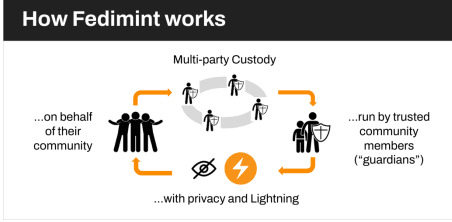
Source: Bitcoin magazine
Eric explores an alternative method in which Bitcoin could replace traditional banks, this time through utilizing a different protocol known as Cashu. Like Fedimint, Cashu utilizes a privacy-preserving eCash supported by Bitcoin, crypto’s store of value. However, Cashu is notably more centralized, operating on a single server. The trade-off is that the centralized aspect allows for efficient monitoring of the eCash circulation without jeopardizing user privacy, which contrasts with the challenge faced by Fedimints, where tracking the supply of eCash is hindered by its inherent privacy features.
Money and e-Cash
In the second part of the report, Eric asserts that a single form of money will eventually become the universal standard for transactions. He argues, “In theory, market participants converge upon a monetary standard. In a perfect world, there would only be one form of money. Yet, throughout history, this has never been the case.” Eric provides three explanations for the historical absence of a singular form of money.
The first is opacity or the general lack of information about other currencies available to the average person. Another reason is governments' desire to control their own currencies, a concept called sovereign coercion. The third factor to consider is the trade-offs associated with money. For instance, in today's world, real estate is often viewed as a more reliable store of value compared to the US dollar, as explained by Eric.
For reference, the concept of money refers to a medium that holds value, while currency is a means of exchange used to purchase goods and services. This video clarifies the distinction between the two, highlighting how they were once equivalent when backed by gold. However, once currency was no longer tied to gold, it lost its value as a form of money. Despite this shift, we continue to operate under the belief that we are working for money through indoctrination, both explicitly and implicitly.
Eric explains we are not out of the woods regarding BTC being the complete solution to this problem. He notes that although BTC addresses numerous obstacles that have previously hindered the widespread adoption of a single currency, it faces its own obstacles regarding scalability (speed) and privacy. The Lightning Network is a potential remedy for Bitcoin's scalability issue, while eCash is a solution for enhancing Bitcoin's privacy.
The report recognizes that while each of these solutions has its own obstacles, they may still effectively address the issue. However, eCash's success in creating viable money markets depends on its ability to gain widespread acceptance and adoption. Without delving into complex details, this process would entail individuals or organizations with substantial financial resources engaging in arbitrage activities between various eCash systems, stabilizing their value relative to the underlying BTC. This positive feedback loop would boost eCash adoption, fostering more precise pricing, increased market-making, and further adoption. The cycle would repeat, driving up the use and reliance on eCash while maintaining a consistent global value.
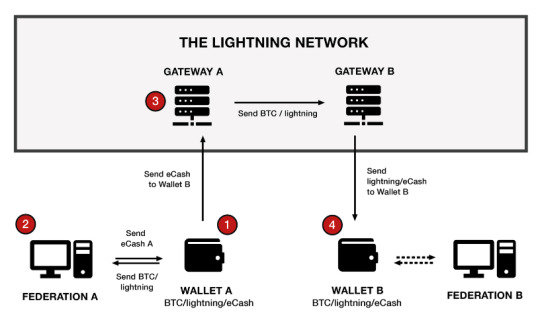
Source: Axiom.BTC
The Potential Risks Of An eCash System
The report's third section highlights the potential risks involved with the eCash system, which is built on Bitcoin (BTC) and utilizes the Lightning Network and Fedimint technology. Eric explains that eCash is designed to be minted and redeemed for BTC on the Bitcoin blockchain or BTC on the Lightning Network using a Fedimint Network. This system should ensure that all types of eCash issued by different Fedimint networks are interchangeable and hold equal value. In other words, eCash minted for BTC using one Fedimint network's lightning Network BTC can be redeemed for Layer One BTC at another Fedimint network.
While Fedimints offers the benefit of privacy for eCash transactions, there is a potential drawback. Specifically, Fedimints can generate more eCash than the amount of BTC that backs it, which could result in an imbalance in the system. For instance, one Fedimint network might produce ten times more eCash than others, causing users to claim a disproportionate amount of BTC from other Fedimints. This issue arises because eCash is entirely private, making it difficult to keep track of the total amount in circulation. This issue is mitigated by using Cashu, which maintains a record of circulating eCash and ensures that BTC always backs it.
Now, there's already a precedent for how to solve this problem. It's called free banking, which is banking before central banks existed. In the free banking era, banks could issue currency at their own discretion. In theory, this currency was backed by gold; in practice, it wasn't always. Unfortunately, this led to a situation where customers were not always aware of the actual value of the currency they were using, as they were at the mercy of the banks' honesty. This information imbalance between banks and their customers can be compared to the privacy aspects of eCash issued by Fedimints, where the issuing authority can access more information than the users.
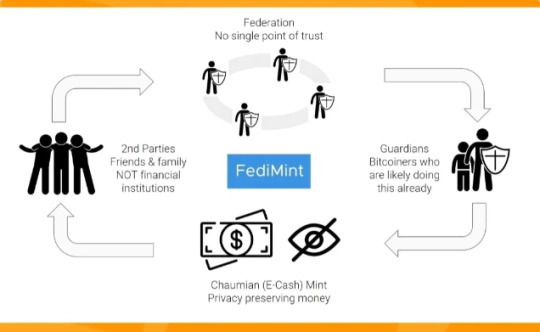
Source: AreaBitcoin
The caveat is that free banks did not have a widespread relationship with all individuals. Only a select few were privy to the financial workings of the free banks, and these were often the first to withdraw their funds before the system collapsed. The report highlights three such groups: competitors, brokers, and clearing houses. Eric suggests similar participants could provide comparable assurances in a decentralized eCash system. This could include entities such as Fedimints, Lightning Network gateways, eCash brokers, and even speculators who wager against unreliable Fedimints. The most crucial participant that could be introduced to an eCash system would be one capable of furnishing proof of reserves.
Those who have been involved in the crypto space since the downfall of FTX will be familiar with the emphasis placed on proof-of-reserves by exchanges aiming to enhance credibility. However, it's important to note that proof-of-reserves alone does not provide insight into a crypto exchange's obligations or debts. This means that an exchange could show evidence of holding $1 billion in BTC for its users who have deposited the same amount while simultaneously being $2 billion in debt, a detail unknown to users.
However, in an eCash system, the concept of liabilities doesn't apply in the traditional sense, as all eCash in circulation is supported by BTC held in a multi-signature wallet. The existence of this BTC collateral ensures the legitimacy of eCash minted by a Fediment, making it unnecessary to worry about liabilities.
Proof Of Liabilities
The fourth section of the report focuses on proof of liabilities. In this context, it alludes to the Cashu-created method for preserving the privacy of eCash users while monitoring the digital currency in circulation. Cashu's proof of liabilities protocol relies on three deliberate steps, which are crucial for its effectiveness.
To publicly commit to regularly rotating its eCash private keys over a predetermined period (“epoch”). This allows all eCash in circulation to recycle from old epochs to the current epoch.
Produce a publicly auditable list of all issued eCash tokens in the form of mint proofs.
Produce a publicly auditable list of all redeemed eCash tokens in the form of burn proofs.
A system with these properties can ensure that Fedimint users can verify whether a mint has issued unbacked eCash during a previous epoch. This system sets an expiration date on user eCash, which prompts users to update their eCash to the latest epoch. The expiration of eCash compels users (through automated processes in their wallet software) to take actions that will lead to the mint disclosing past eCash issuance and redemptions.
The intriguing aspect is that the periodic alteration of eCash private keys is designed to mimic a bank run on the Fedimint. If the Fedimint is unable to modify the private keys used for eCash minting, it suggests that the eCash they've issued is not supported by the BTC reserves they claim.
In the fifth section of the report, Eric examines the possibility of a Bitcoin eCash system being impervious to political influence, provided that there is a sufficient number of decentralized financial networks, known as Fedimint networks. The report speculates that up to 10 million digital community banks could be in the future. Additionally, the report highlights that Fedimint networks are also resistant to politics because they are currently exempt from financial regulations but admit that this could change. If you’ve followed the crypto regulation saga, you would know that the authorities’ goal is ending all custodial crypto.
The sixth section of the report analyzes why Bitcoin and the Lightning Network are deemed inadequate. The report then shifts its focus back to comparing free banking with the eCash system in the seventh section. The risks associated with each system are highlighted in a diagram presented below.

Source: Axiom.BTC
The report then discusses the potential for Fedimints to start practicing fractional reserve banking. For those unfamiliar with the concept, fractional reserve banking refers to retaining only a portion of the funds backing a currency in circulation. Most financial institutions worldwide maintain a reserve requirement of less than 30%, meaning they must hold 30 cents for every dollar they have issued.
Significantly, the Federal Reserve eliminated all reserve requirements for American banks at the onset of the pandemic and has seemingly yet to reinstate them. Eric highlights that this has raised concerns that Fedimint networks may begin operating like fractional reserve banks, meaning they would issue more eCash than BTC in reserve. However, competition among Fedimints is believed to help mitigate this risk, with those maintaining full reserves coming out on top.
Emerging Technologies
In the latter section of the report, the discussion revolves around new technologies that can bring the eCash concept to life. Eric highlights a novel protocol named Ark, currently in its conceptual phase and can be viewed as a mixing service and an onboarding mechanism that minimizes on-chain activity. Like the Lightning Network (LN) has LSPs, Ark will have Ark Service Providers (ASPs). This is a solution to the onboarding problem and a trustless custodial solution.
Interestingly, Ark's main limitation is that it can only support up to 10.5 million BTC due to technical reasons outlined in the report. Despite this, Eric believes this inherent restriction could be advantageous in the long run. The main point to remember is that Ark has the potential to overcome the technical challenges faced by the eCash system. As noted by Eric, “The Arc protocol could provide the necessary infrastructure for a trustless free banking system of service providers to emerge, removing agency from fundamental economic functions.”
Next, Eric synthesizes the information in the concluding section of the report, presenting a comprehensive overview as follows:
“Imagine a system where users dollar-cost-average into Bitcoin via Ark, use federated technology for custody, use eCash as the private cash balance for everyday transactions, and on the backend, all service providers are clearing balances between one another via the Lightning Network. Fedimints and ASPs could act as banking infrastructure, and the LN could act as the clearing houses amongst them as a hub and spoke model.”
In essence, it is a monetary framework of decentralized, community-owned, and operated digital Bitcoin banks.
What It Means For BTC
The potential impact on Bitcoin (BTC) is significant, assuming the implementation of the eCash system as described. Such a system would generate substantial demand for BTC, thereby boosting its value. In essence, the eCash aspect of this alternative financial system would serve as a powerful catalyst for BTC's growth.
The more significant concern is how this trend might impact both the financial system and your personal financial autonomy. It's important to remember that economic freedom doesn't equate to having a large sum of money. Instead, it means having the flexibility and control to make choices about your money whenever you see fit. Unfortunately, this level of autonomy is becoming increasingly scarce in traditional financial circles.
As previously stated, having a large sum of money in your bank account may hold little value if you cannot use it. When encountering someone with significant wealth, inquire about the challenges of managing such funds. The process of transferring large sums of money is complex and increasingly so. This difficulty may be attributed to the fractional reserve banking system's ongoing trend towards extreme fractionalization. Put simply, banks are putting up hurdles that make it harder to move your money around because the cash you have there doesn't even really exist.
The banking crisis from last year highlighted how convenient it is to transfer money in today's world. In the past, customers would have to physically line up at the bank to withdraw their money in the event of a problem, which is the classical definition of a bank run. Nowadays, all you need to do is click a button, which is a big problem for banks.
In any case, the growing sentiment globally is towards a financial framework that enables individuals to possess their assets and maintain their financial autonomy. The system examined in this report may or may not be the ultimate answer, but it's undoubtedly a move in the right direction toward a future where such a system will be imperative.

Image: Markethive Wallet
On The Right Side Of History
Markethive is also on the right side of history regarding financial sovereignty and keeping the entrepreneurial spirit alive. It is a domain where the individual can thrive in an expanding community of critical thinkers who uphold liberty and free expression, prioritize financial autonomy, and foster an environment where ingenuity and independence can flourish. These aspiring and seasoned entrepreneurs alike reject the constraints established financial systems impose and embrace the potential of decentralized technology.
In response to the autocracy of governments and mega-corporations on a global level, Markethive has developed its own comprehensive financial accounting hub that can be likened to a bank. This system provides users with a secure platform for financial transactions, including merchant accounts, free from the risk of account closure or seizure by authorities seeking to restrict freedom of expression for any reason.
Markethive’s evolution will include multiple sovereign servers to avoid being censured or shut down and a dynamic and innovative crypto exchange that leverages the platform's unique strengths, including innovative inbound marketing strategies, blogcasting capabilities, dynamic social engagement, and community-driven support. These endeavors are a natural progression for Markethive, allowing it to expand its reach and provide users with a seamless trading experience that integrates the platform's proven features.
With divine guidance, we will resist the oppressive totalitarian regimes that seek to subjugate humanity. Despite the power wielded by the elite, tech titans, government, and mega-corporations, a higher authority exists that eludes their control. The discerning individual cannot help but perceive the larger forces at play.
This article is provided for informational purposes only. It is not offered or intended to be used as legal, tax, investment, financial, or other advice.


Editor and Chief Markethive: Deb Williams. (Australia) I thrive on progress and champion freedom of speech. I embrace "Change" with a passion, and my purpose in life is to enlighten people to accept and move forward with enthusiasm. Find me at my Markethive Profile Page | My Twitter Account | and my LinkedIn Profile.
0 notes
Photo

New Post has been published on https://cryptonewsuniverse.com/trad-fi-wants-to-dominate-crypto-is-it-succeeding-what-does-it-mean-for-crypto/
Trad-Fi Wants To Dominate Crypto Is It succeeding? What Does It Mean For Crypto?


Trad-Fi Wants To Dominate Crypto. Is It succeeding? What Does It Mean For Crypto?

Charles Hoskinson, the founder of Cardano, is a prominent figure in the cryptocurrency industry and is known for his unwavering belief in its potential to revolutionize the financial system, much like Markethive. Throughout the years, I have documented the evolution of Cardano creator Charles Hoskinson's efforts in developing the Cardano protocol and his humanitarian quest.
In a recent video, Hoskinson expressed his concern that the traditional financial system is slowly but surely taking over the crypto industry, a notion that has sparked a heated debate among experts. While cryptocurrency's original intention was to supplant traditional financial systems, some fear that if it continues on its current path, it may ultimately become even more dystopian than any central bank digital currency.
In a live video broadcast on February 13, 2024, Charles passionately shared his thoughts on the intersection of legacy finance and the crypto world, titled "Legacy is Eating Crypto." This article summarizes Charles' insights, supplemented by perspectives from Coin Bureau's crypto experts. We will also explore ways in which the crypto industry can safeguard itself from being overtaken by traditional financial institutions, commonly referred to as "Trad-Fi."
Stablecoins
Charles started by mentioning that he has been discussing the significance of decentralized algorithmic stablecoins in various recent interviews and how they differ from centralized asset-backed stablecoins, which he believes could threaten the cryptocurrency industry.
A stablecoin that relies on algorithms to maintain its value relative to a traditional currency is known as an algorithmic stablecoin. The most well-known example of such a stablecoin is Terra's UST, which suffered a collapse around May of 2022. However, Charles had a different type of algorithmic stablecoin in mind; he was referring to a stablecoin that is backed by another cryptocurrency, such as MakerDAO’s DAI, which can be minted by locking up another crypto as collateral, such as ETH.
The issue is that DAI may not be genuinely decentralized anymore, as it is now primarily backed by centralized assets. This makes it similar to other centralized stablecoins, such as Circle’s USDC and USDT, which Charles categorizes as asset-backed. Like USDC and USDT, DAI's value is supported by real-world assets, specifically US government debt and US dollars, which are susceptible to seizure.
For context, Charles shared some key facts. Firstly, he mentioned that centralized stablecoins constitute approximately 10% of the total market capitalization of cryptocurrencies. While this may not seem significant initially, it becomes notable when considering the second statistic: about 70% of all cryptocurrency transaction volume involves a centralized stablecoin. Charles emphasized that centralized stablecoins such as USDC and USDT are minted and redeemed by centralized companies that are typically subject to strict regulations. He explained that while these regulations are not inherently harmful, they imply that these entities are under government oversight, unlike cryptocurrencies.
Moreover, these entities are restricted in their ability to drive innovation in stablecoins, as they must operate within the boundaries of regulatory compliance. Additionally, they cannot issue stablecoins in a fractionalized manner, meaning that an equivalent value of US dollars or bonds must fully back each stablecoin in circulation. This poses a significant challenge, as it enables centralized stablecoin issuers to potentially influence the outcome of a hard fork by deciding which chain becomes the dominant one.

Source: Investopedia
In other words, they would have to select which chain to transfer all their stablecoins to, as doubling the supply isn't an option. Interestingly, Vitalik Buterin, the creator of Ethereum, acknowledged this reality in 2022. He opined that Circle, the issuer of USDC, could dictate which chain emerges victorious in the event of an Ethereum fork. It is worth mentioning that Cardano is not exposed to this threat since it does not currently support any centralized stablecoins.
Bitcoin ETFs
Charles then pointed out the possibility of centralized stablecoin issuers implementing KYC at the blockchain level. He also highlighted criticisms regarding the absence of centralized stablecoins on the Cardano blockchain. Charles emphasized that those advocating for centralized stablecoins on Cardano without considering the associated risks are solely focused on increasing the value of the ADA token. He also drew parallels to the situation with spot Bitcoin ETFs, highlighting that these ETFs now hold over 200,000 BTC valued at over $10 billion, and argued that asset managers operating these ETFs wield a similar level of influence over Bitcoin as Circle does over select smart contract cryptocurrencies.
This stance is both intriguing and controversial. On the one hand, it suggests that the forecast about Circle's rise to prominence in cryptocurrency is materializing. On the other hand, there is room for debate as asserting control over Bitcoin involves more than just influencing its price. While Charles posits that the growth of spot Bitcoin ETFs could allow them to control Bitcoin in the event of a fork, this argument is not without its critics. Some argue that controlling Bitcoin requires more than just price manipulation. However, Charles suggested that with the ongoing absorption of BTC by spot Bitcoin ETFs, there is a possibility for these entities to amass enough control to potentially dominate Bitcoin in case of a fork.
For reference, in its ETF filing, BlackRock clearly mentioned that it would decide which Bitcoin fork to back in the event of one. Consider a situation where Bitcoin splits into proof-of-stake and proof-of-work networks. The likelihood is high that BlackRock and other asset managers would choose to support the proof-of-stake fork because their significant BTC holdings would essentially give them control over the new Bitcoin blockchain through their spot ETFs.
The irony is that ESG-obsessed asset managers are more concerned about the government's control over Bitcoin rather than its environmental impact. While proof of stake is praised for its eco-friendliness, the control aspect truly holds significance. Moreover, asset managers like BlackRock could offload their proof-of-work BTC holdings after a fork, causing the price to plummet and making it unprofitable for miners to continue validating transactions. This could ultimately lead to the demise of the proof-of-work chain.

Source: Coinmarketcap
Charles emphasized that the dominance in the crypto industry lies not only with stablecoin issuers and asset managers but also with centralized exchanges where the top three control the majority of trading volume. According to Charles, there are just ten entities that have the potential to control the crypto market. However, considering Blackrock's partnership with Coinbase and its management of USDC's reserves, it's likely that the number of entities with such control is even smaller. Furthermore, Blackrock's influence extends to the US government, as evidenced by a recent lawsuit settlement with Binance granting it extensive oversight over the exchange.
In any event, Charles proceeded to make an intriguing statement, highlighting that if you ignore the advice of these organizations, they will not add your cryptocurrency to their list, and they will not introduce a stablecoin on your blockchain. This brings up the question of whether this is the reason Cardano lacks a centralized stablecoin – due to their unwillingness to adhere to such requirements.
Cardano
Charles noted that Cardano has successfully avoided being controlled by centralized stablecoin issuers and their associates, which has led to it being overlooked and undervalued. He pointed out an explicit prejudice against Cardano within certain industry circles. Charles reiterated that many in the Cardano community are growing impatient with ADA's price action and are “trying to invite the vampires in so that ADA's price will pump.”
Charles expressed that it's not his place to make a decision, but he felt others needed to understand the implications of their choices. He emphasized that if vampires are allowed to enter, they will eventually hold power over everything related to Cardano. However, he also suggested that ADA could be delisted if it doesn't meet the standards of trad-fi-backed crypto elites. Charles stressed that every decision in crypto comes with a trade-off; nothing is free. He posed the question of whether the purpose of crypto is to perpetuate existing inequalities or to stop them.
He questioned whether the goal of cryptocurrency was to conform to the institutions responsible for economic disparity or to break free from their control. To emphasize his point, he noted that increasing centralization in crypto mirrors the corrupt financial system it seeks to challenge, encompassing centralized infrastructure, centralized exchanges, and centralized stablecoins. Eventually, there will be wallet-wide KYC and CBDC integrations.
During a podcast with Bankless, Circle CEO Jeremy Allaire indirectly acknowledged that Circle's USDC ultimately aims to evolve into a central bank digital currency (CBDC). As you may already know, CBDCs will give governments and central banks complete authority over individual saving and spending habits. In fact, some argue that stablecoin issuers already wield such power.
The end result of this shift towards centralization will be identical to the permission systems and de-platforming present in the financial sector today. One needs to look no further than the COVID-19 protests in Canada for proof of this. Protesters and their supporters found their bank accounts frozen. Charles emphasized that cryptocurrency will become inconsequential if it integrates with trad-fi and that they will do everything in their power to ensure that it does, whether by influencing regulations or using other means.
Finally, Charles explained that Satoshi Nakamoto's motivation for creating Bitcoin was a response to the extraordinary measures taken during the 2008 financial crisis and the concerning precedents they established. Satoshi believed that cryptocurrency could offer a unique alternative, but first, it's essential to recognize how it's still mirroring the same patterns as traditional finance. Unfortunately, Charles did not elaborate on how cryptocurrency could diverge from these patterns, whether through algorithmic stablecoins or other means, to avoid falling under the control of traditional financial systems.
Why BTC Could Be Unscathed
Thankfully, the task is relatively simple, although implementing it will be challenging and involve tradeoffs, as Charles pointed out. Your viewpoint will ultimately determine the approach. To elaborate, let's revisit the premise of Charles's video, which suggests that ‘legacy’ or trad-fi is ‘eating’ or integrating cryptocurrency rather than vice versa. Some believe that incorporating crypto, to some extent, is crucial for promoting awareness, acceptance, and progress in the field.
The current state of crypto privacy regulations is a prime illustration of this issue. Globally, regulations surrounding cryptocurrency are heavily leaned against privacy, with the supposed reasoning being that it creates an environment conducive to illicit financial activities. However, the true motivation behind this stance is that powerful financial institutions desire total visibility into all transactions, allowing them to maintain control over the economy and suppress any potential competition.
The main point is that these influential financial organizations' primary desire for privacy comes from them. This is evident in Blackrock's and other companies offering Bitcoin ETFs' decision to keep the wallets containing the BTC supporting their ETFs undisclosed. In contrast, Bitwise chose to reveal this information preemptively rather than waiting for blockchain analysts to uncover it.
Consider the possibility that stablecoin payments will become widespread globally, thanks to the lobbying efforts of stablecoin issuers like Circle. It won't take long for individuals to realize that their stablecoin transactions and balances are transparent to everyone, which may raise concerns among trad-fi elites. Moreover, with central banks permitted to hold cryptocurrencies on their balance sheets starting from January 2025, there will likely be growing pressure on regulators to enhance privacy in the crypto space.
The rise in crypto privacy use will lead to the creation of additional privacy solutions. Cryptocurrency operates on universal principles, applying the same rules to all blockchain users. As long as this remains true, influential individuals and organizations will likely advocate for crypto values as they align with their self-interests.
If you are still in the process of being convinced, consider that various central banks globally are in the stages of creating their individual digital currencies. Given their ease of seizure or freezing, will these central banks rely on each other's digital currencies? The answer is no. Consequently, there'll be a significant need for a reliable, mutually accepted digital currency, especially as the world becomes increasingly geopolitically divided.
Coinbureau believes that Bitcoin's BTC is well-suited to serve this purpose and is currently used for trading by certain countries. Moreover, there are reports of countries engaging in Bitcoin mining activities. This could lead to a situation where nations using BTC for trade may compete in mining to maintain the neutrality of the Bitcoin blockchain. Fidelity, a different asset manager, has made a similar prediction.
This relates to Charles' assertions regarding asset managers' influence over Bitcoin through controlling its value. Recognizing that BTC's main advantage is its status as a trustworthy and impartial digital currency beyond anyone's control, it becomes clear that attempting to control Bitcoin would have negative consequences. To clarify, if Blackrock and other asset managers were to gain control of Bitcoin, its fundamental appeal would cease to exist.
The potential outcome of this situation is substantial funds being redirected to alternative assets, such as gold and other cryptocurrencies, which are beyond the control of asset managers. Notably, these outflows could potentially include investments in the proof-of-work BTC fork. It's important to remember that Blackrock's significant wealth and influence are largely predicated on the dominance of the US and its currency.
As explained in this article, the emergence of a new commodity cycle could potentially elevate the influence of the BRICS nations. Consider a scenario where one of these countries introduces a Bitcoin exchange-traded fund (ETF) that tracks the price of the proof-of-work version of Bitcoin derived from Blackrock's proof-of-stake fork. If this were to happen, it could attract tens of billions of dollars in investments.

Image: Markethive.com
How Crypto Strikes Back
This scenario is conjecture right now, and it is essential to take a broader view. This analysis considers long-term aspects and does not encompass the entire cryptocurrency market. In the shorter term, there is a possibility of integration between the rest of the crypto market and trad-fi in a manner that may present challenges. Small Blockers actually predicted this during the block size wars.
Notably, trad-fi investors attempted to take control of Bitcoin by increasing its block size. However, they were unsuccessful in their efforts and shifted their focus to other cryptocurrencies, such as Ethereum. Since then, events have unfolded as predicted by proponents of Small Blockers. Essentially, if crypto aims to rival trad-fi in aspects like speed and cost, it will ultimately result in greater centralization, as it becomes a race to the bottom.
In the past ten years, we have witnessed a trend where each new generation of cryptocurrencies has become increasingly centralized. This has made them vulnerable to regulatory capture. As with Blackrock potentially controlling Bitcoin, centralized cryptos becoming subject to trad-fi regulations will essentially make them the same as existing traditional financial solutions, leading to decreased user adoption, with no one using them. Recognizing this risk, investors in these cryptocurrency projects are now shifting their focus toward achieving maximum decentralization.
Decentralization goes beyond just the quantity of nodes and validators. It encompasses the level of developer involvement in the blockchain, the dispersal of the coin or token, particularly in proof-of-stake blockchains, and even the infrastructure utilized by miners and validators, as detailed in this article.
The decentralized nature of cryptocurrency comes with inherent trade-offs, such as slower transaction speeds and higher costs. This brings us back to the root problem: that most crypto companies are attempting to compete with traditional finance in terms of cost and speed. However, this has created a problematic trend towards centralization, which risks undermining the fundamental principles of decentralization that define cryptocurrency. If left unchecked, this race to the bottom could result in the most widely adopted cryptocurrency being managed by a single entity, such as the Federal Reserve. This outcome would be at odds with the vision of crypto enthusiasts, who seek to maintain the decentralized nature of cryptocurrency. So, what steps can be taken to address this issue?
As opined by Coinbureau, the solution is to let the crypto industry learn the importance of decentralization the hard way. As with most things in modern society, the only way you'll get change is with some kind of shock. In this case, it could be Circle deciding which Solana fork we could see in the future. It could be Tether freezing everyone's USDT holdings until they complete KYC. It could be Coinbase banning crypto transfers to and from personal wallets like many regulators want to do. It could be Blackrock’s spot Ethereum ETF taking control of Ethereum with all the ETH it will inevitably hold.
The average investor and user will likely realize the significance of decentralization in the crypto space only when confronted with situations that highlight its importance. As previously mentioned, this realization will also dawn on influential individuals and organizations. Subsequently, new cryptocurrencies that prioritize decentralization will emerge, hopefully without the need for a catalyzing event.
The cryptocurrency sector is anticipating potential threats and adapting accordingly. Early indicators of this trend include the emergence of decentralized privacy protocols and venture capitalists' financial support for algorithmic stablecoins. Initially, this may come as a surprise. Still, upon closer examination, it aligns with the motivations of major players like BlackRock, Coinbase, and Circle, who are ultimately driven by the desire to generate profits, just like many others in the cryptocurrency space. By investing in innovation, they will likely yield financial gains, which explains their support for pro-crypto regulations.
It's interesting to note that the institutions that have been perceived as obstacles to the growth of cryptocurrency are actually the ones that stand to benefit the most from its innovation. Governments, megabanks, and central banks are feeling the pressure of competition from crypto, and they are the ones hindering the progress of cryptocurrencies and working against it to maintain their power and control. It may seem far-fetched, but major players like Blackrock & Co. could be aligned with the interests of cryptocurrency enthusiasts in this battle despite their questionable reputation and difficulty in trusting them. Consider the potential profitability of displacing governments, megabanks, and central banks – it's food for thought.


Editor and Chief Markethive: Deb Williams. (Australia) I thrive on progress and champion freedom of speech. I embrace "Change" with a passion, and my purpose in life is to enlighten people to accept and move forward with enthusiasm. Find me at my Markethive Profile Page | My Twitter Account | and my LinkedIn Profile.
0 notes
Photo

New Post has been published on https://cryptonewsuniverse.com/censorship-industrial-complex-on-steroids-with-ai-an-insane-attempt-to-threaten-free-speech-goes-next-level/
Censorship Industrial Complex On Steroids With AI An Insane Attempt To Threaten Free Speech Goes Next Level


Censorship Industrial Complex On Steroids With AI. An Insane Attempt To Threaten Free Speech Goes Next Level

The erosion of confidence in governments globally has led to a surge in efforts to suppress dissenting voices and limit the dissemination of information deemed unfavorable by those in power. In other words, truths they don’t like. The recent Congressional Hearing on the Weaponization of the Federal Government has exposed the alarming extent to which some governments are willing to go to silence opposition and maintain their grip on power.
It has shed light on a disturbing trend: the integration of artificial intelligence (AI) that will enable the government to suppress what it considers as mis or disinformation with unprecedented efficiency and effectiveness. Using AI for censorship has created a dangerous alliance between government agencies and powerful corporations, further undermining the principles of democracy and the ability to seek the truth and speak the truth.
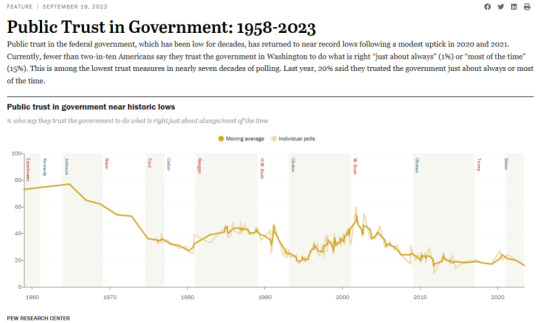
Source: Truthstream Media X
In early February 2024, a subcommittee hearing was held to discuss the recent attempts by governments and agencies to censor online content, posing a threat to the fundamental right to free speech. This summary highlights the key points and issues addressed during the hearing and ways to resist these efforts and safeguard your constitutional freedom of expression.
To begin, a brief overview is needed. A political committee at Capitol Hill focuses explicitly on examining how the government's powers are being utilized as weapons. This committee was formed in January 2023 and has stirred up much debate. This is mainly because most of the subcommittee's discussions have centered on critiquing the current administration's utilization of governmental authority. While these discussions may seem biased, the substance of the dialogue holds value.
According to the Judiciary Committee's website, the hearing focuses on the federal government's role in funding the development of high-powered censorship and propaganda tools that governments and big tech can use to monitor and censor speech at scale.

Source: Judiciary Committee
From all accounts, the hearing was convened in response to a recent exposé by The Daily Caller, which revealed that the National Science Foundation (NSF), a separate government agency in the US, had allocated $40 million towards developing online censorship tools. The report's author, Katelynn Richardson, suggests that this investment is part of a more considerable effort by the U.S. government to create a "censorship industrial complex" through the funding of AI research initiatives.
Just so you know, governments globally are following suit and implementing similar measures to curb online freedom. This article provides an overview of the various internet censorship laws enacted worldwide.
Katelynn was among the four individuals who provided testimony. The other three witnesses were Greg Lukianoff, CEO and President of the Foundation for Individual Rights and Expression (FIRE), Lee Fang, an investigative journalist known for his work on the Twitter files, which exposed collaboration between big tech and governments to silence dissenting voices, and Norman Eisen, a former U.S. Ambassador to the Czech Republic.
It's worth noting that although the motivations behind this hearing were likely partisan, the information that came to light is crucial for everyone to be aware of, regardless of their political affiliations or geographical location.
The utilization of these powerful instruments is not limited to any particular administration or government. Consequently, it's essential to recognize that the same tools employed against individuals you disapprove of today could be directed toward you in the future. The notion that you may hold a non-partisan stance does not necessarily ensure your immunity, as historical patterns suggest a tendency towards the escalation of such measures. Some might argue that we're currently witnessing the manifestation of this phenomenon.

Source: Judiciary.House.gov
The Hearing – Opening Statements
The hearing commenced with opening statements from politicians from both Republican and Democrat parties. Chairman Jim Jordan was the first to address the assembly, and he began by enumerating instances where the U.S. government had collaborated with major technology companies to suppress legitimate speech. His list was extensive and included several notable examples. Additionally, he drew attention to a recent investigative report that revealed the U.S. government had pressured Amazon to restrict specific book titles on its platform during the pandemic.
Jim expressed concern that censorship tactics are advancing with generative AI technology, which has gained widespread attention. He referenced quotes from studies on censorship funded by the U.S. government, highlighting the potential for these tools to circumvent legal responsibility by operating through automated programs rather than individuals subject to legal repercussions.
However, the most incriminating statement highlighted the fact that certain studies are deliberately aiming to reach rural and indigenous communities, veterans, older adults, and military families through their internet censorship mechanisms, as they believe these groups are the most susceptible to mis and disinformation. It insinuates these minorities are too stupid to know the truth. Or perhaps these demographics often place their faith in entities beyond the government's control, posing a challenge for those in power.
Jim then disclosed that another proposal document stated that reactive content moderation (usually performed by humans) is too slow and ineffective. The focus is, therefore, on certain tools that implement proactive censorship, meaning that any online content you post will be censored before you complete typing it. Notably, these are the types of concepts that have been extensively debated at the World Economic Forum's yearly gatherings.
Ranking member Stacey Plaskett was the next speaker, and she rejected Jim's remarks as a conspiracy theory. She expressed her frustration that she has to sit through repeated discussions on the subject, six times to be exact, emphasizing that the real weaponization of the government occurred during the prior administration.
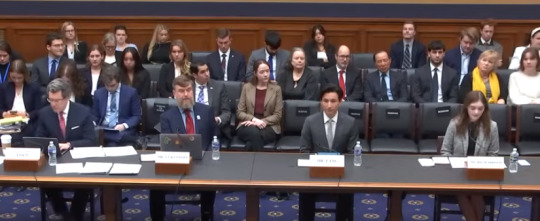
Source: Video of hearing
Witnesses Opening Statements
The witnesses had their chance to share their opening statements, free from the influence of partisan agendas. First, Katelynn Richardson began by expressing her concern about the U.S. government's potential involvement in creating a censorship-industrial complex. She then disclosed that numerous censorship studies she uncovered last year are still in progress.
Katelynn pointed out that a censorship-industrial complex is rising as a new sector receiving substantial government funding, not unlike the expanding crypto compliance industry aimed at satisfying the Financial Action Task Force (FATF). She noted that she has questioned these entities about their studies. Katelynn also mentioned that she had challenged these institutions about their research. In response, they initiated a marketing campaign to justify their censorship efforts as a means of safeguarding democracy. This excuse has become a common justification for government overreach in recent times.
Lee Fang, the second witness to testify, discussed the potential for AI to facilitate unparalleled levels of censorship. He drew from his personal experience working on the Twitter files to illustrate how large pharmaceutical companies and their affiliated organizations have partnered with big tech to suppress online content.
Lee recently shared that although these programs were paused after the pandemic, they were reinstated around the middle of last year. He pointed out that various tools created by governments to combat terrorism are now being utilized against their own people. He cautioned that these tactics could be exploited by whoever was in power to silence political adversaries and emphasized the need for a nonpartisan approach to the committee's work.
Greg Lukianoff was the third witness to give testimony. He described how FIRE works to protect free speech rights from government interference nationwide, advocating for both right-wing and left-wing causes. He warned that the battles they have fought so far will seem insignificant compared to the challenges that lie ahead with the emergence of AI. Additionally, Lukianoff highlighted the issue of AI alignment, which, in theory, involves teaching AI to follow instructions but, in practice, often translates to teaching AI to comply with government dictates.
Greg emphasized that artificial intelligence (AI) is merely a tool that can enhance freedom of speech, much like the internet. He drew an analogy between the internet, AI, and the printing press, which brought about the downfall of religious control over governments. However, Greg noted that this is only possible if AI can develop freely in a decentralized environment without excessive regulation. Over-regulation risks undesirable consequences such as censorship and may hinder the United States' technological competitiveness.
Norman Eisen took his turn to speak, displaying a strong bias typical of such hearings by passionately advocating for government collaboration with major tech and AI companies. He dismissed accusations of fearmongering from his fellow panelists and asserted that it is permissible for the government to engage in such partnerships. Furthermore, he stressed that the government has the right to express its reservations to tech giants and to fund various AI initiatives. Eisen also revealed his initiative to provide a scholarship for individuals interested in delving into the intersection of AI and democracy.
The Q&A Session Begins.
Thomas Massie [R] was the first to pose a question during the session. He directed his inquiry to Lee, who disclosed a shocking revelation regarding the government's utilization of AI censorship initiatives. A program is in place that employs the creation of AI-powered social media bots designed to engage in arguments with individuals whom the government deems to be propagating false or misleading information.
In other words, if you have ever voiced an opinion on social media that contradicts the government's stance and subsequently received a barrage of responses from suspicious-looking accounts, these were likely AI bots funded by the government.
Regrettably, the left-leaning politicians chose to overlook the AI censorship problem caused by the current government, dismissing it as a futile concern. Instead, they emphasized the perceived bleak and harmful consequences for the United States if Donald Trump were to win the presidential election. This biased stance was unproductive and not deserving of attention here; however, you can find the complete hearing by following this link, which is worth viewing. Following my initial frustration, I found myself chuckling.
Kelly Armstrong [R] presented a comprehensive list of the U.S. government for research on censorship and inquired with Katelynn about a specific grant aimed at training students for job roles related to disinformation. This initiative represents what Katelynn referred to as the censorship-industrial complex. She affirmed that this program was indeed a summer internship opportunity for students who had received government funding. Kelly then questioned her about the curriculum focusing on recognizing misinformation.
Katelynn said there were many things, but the primary emphasis was on election-related information. The fact that more than 4.2 billion individuals worldwide are expected to participate in elections this year is quite alarming. It appears that governments are determined to maintain the status quo by supporting established candidates. The question then arises: Why have they yet to introduce a transparent blockchain voting system? The likely answer is simple enough to figure out.
After an unrelated partisan commentary and one question directed at Norman Eisen about Trump from anti-crypto politician Stephen Lynch [D], Jim questioned Lee Fang about his opening statement, specifically regarding a 2012 hearing on government funding for censorship programs. Jim confirmed that this was indeed the case and that the opposing political party was pushing for online censorship at the time. However, Greg Lukianoff pointed out that the tables have now turned and that one should not celebrate using these tools, even if they are being used against individuals they dislike, as they could potentially be used against them in the future.
The queries continued, with John Garamendi [D] taking his turn. Similar to his political peers, his inquiry was tainted with partisanship. Nevertheless, he disclosed a noteworthy detail: conservative groups have devised a strategic plan called Project 2025 to reform the U.S. government. This information is significant because it suggests that the growing opposition globally may not be as spontaneous as it appears and seems to be controlled.
In plain terms, the various individuals and organizations claiming to challenge the current state of affairs are, in fact, integral to the same dominant system they purport to oppose. A prime illustration of this phenomenon is that numerous purported opposition leaders who have risen to power in various nations are affiliated with the World Economic Forum (WEF). This article reveals how the WEF maintains programs designed to assist their preferred candidates in attaining elected office globally.
It is improbable that Project 2025 has any connection to the World Economic Forum (WEF), considering the initiative is reportedly led by the Heritage Foundation, whose president gained widespread attention for criticizing the WEF at the Davos gathering.
Following some biased inquiries from Darrell Issa [D] and Stacey Plaskett [D], Greg Steube [R] queried Lee about NewsGuard, an organization that assesses the accuracy of news sources. Lee indicated that he had devoted considerable effort to researching NewsGuard and described it as part of the expanding misinformation industry.
Lee discovered that NewsGuard has secured military agreements and is exerting an impact on how traditional media covers topics related to foreign policy. This development is not surprising given the history of the CIA's Operation Mockingbird. This program was used to manipulate US media outlets for propaganda during the Cold War. Although Operation Mockingbird officially ended in the 1970s, many believe that its practices continue to be employed in some form today.
Following a series of partisan questions from Representatives Sylvia Garcia [D] and Dan Goldman [D], who claimed there’s no evidence of government coercion regarding social media censorship and reiterated the committee was a useless waste of time and “the true weaponization, the threat of weaponization of the federal government is Donald Trump and the Republicans, and we should move on from this charade.”
The chairman, Jim Jordan, interjected to point out that Dan Goldman had previously acknowledged in a related hearing that the U.S. government had been requesting big tech companies to remove certain content but that these companies had only complied with such requests 35% of the time.
Kat Cammack [R] reinforced Jim's message by stating she has tangible evidence of the censorship previously orchestrated by the present government and agencies. She also emphasized that the purpose of the hearing was not to engage in political posturing but to confront the growing threat of digital authoritarianism emanating from the US government. She stressed that this issue affects everyday citizens and warned that those who assume they are immune will be caught off guard.
Despite this, the hearing continued to be impured by partisan bickering, with Stacy Plaskett [D] leading the charge and Harriet Hageman [R] attempting to set the record straight. Harriet also highlights that the upscaling of AI technology can provide censorship operations, and the scope of it is astonishing. Quoting an example of one company’s pitch to the NSF boasting that it was using AI to monitor 750,000 blogs and media articles daily as well as mining data from the major social media platforms.
Pro-crypto politician Warren Davidson [R] finally had his turn to speak. He brought up a topic that other speakers avoided discussing: the potential creation of a digital identification system by the US government. Warren then turned to Greg for data supporting the claim that censorship is increasing. Greg shared a surprising statistic – 2020 and 2021 recorded the highest number of college professors terminated in the United States since the 1930s.
Greg highlighted that professors across the political spectrum have been affected. He continued to assert that removing academics who resisted conforming to the prevailing norms amid the pandemic has paved the way for a potentially dystopian future in artificial intelligence. Greg pointed out that the remaining scholars, who are now working on AI censorship technology funded by the government, have all complied with the imposed expectations.
Following some politically charged remarks by Jim, Russell Fry [R] made a striking observation. He pointed out that to secure government funding for research related to censorship, one must actively seek it out. This implies that individuals who receive such grants are, in effect, proactively seeking to expand their censorship capabilities from the get-go.
Russell sought Greg's insight on addressing the issue, and Greg's response was illuminating and unexpected. Contrary to popular belief, Greg argued that relying on regulations would not be effective, as it would inevitably lead to further centralization and increase the risk of future control mechanisms. Instead, the key to resolving this problem lies in decentralization, specifically developing and implementing decentralized AI systems that preclude any single entity from wielding such control.
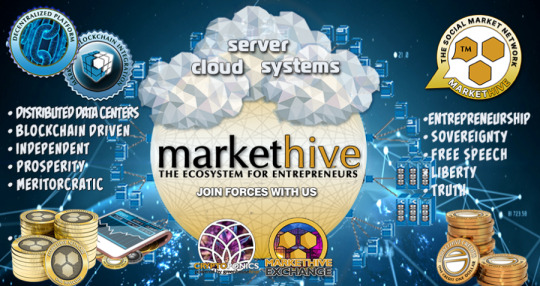
Image by Markethive.com
Combating Online Censorship
The pressing concern now is how to counteract the growing online censorship trend. The first step is to acknowledge the importance of presenting truthful information in a composed and well-reasoned manner, supported by logical arguments and factual evidence. By doing so, we can effectively communicate our message and create a more informed public discourse.
Frequently, individuals try to communicate the truth using exaggerated language, offensive remarks, and other content that may be considered offensive, which can lead to censorship regardless of the message's intent. While some argue that individuals should be free to express themselves in such ways, the reality is that such language may not be tolerated in all cultures and societies. In some countries, like the US, there is a greater emphasis on freedom of speech, but in other parts of the world, there are stricter guidelines around what can and cannot be said.
The second approach is to choose which issues to address carefully. As many people do on specific platforms, there is no point in screaming about an issue into the void. Similarly, arguing with government-backed AI bots supported by the government is usually unproductive. If it is unlikely that anyone's perspective will shift, it is better to refrain from the discussion. Instead, consider sharing your concerns with someone open to listening and empathizing. It is more effective to communicate truths with individuals you are familiar with, as this may lead to the information being disseminated effectively.
This relates to the third point, recognizing that the type of AI-based censorship many governments implement can only occur on specific social media platforms. Engaging with like-minded individuals in person or online makes you less likely to experience its effects. However, it is essential to avoid isolating yourself within an echo chamber.
It's crucial to recognize that avoiding the issue of censorship won't make it disappear. It can eventually impact you if left unaddressed, even if you try to ignore it. Unfortunately, it might not always be possible to fight back. Fortunately, though, you don't always need to.
This pertains to the fourth solution, which involves utilizing alternative platforms that are not vulnerable to online censorship being imposed. Although centralized platforms that uphold free speech still exist, they are under increasing scrutiny by authorities and will likely have to adhere to regulations. As a result, decentralized platforms have emerged as the sole alternative, providing an unrestricted space for online interactions.
This article about the narratives of the next crypto bull market illustrates that decentralized social media is becoming a prominent force as the authorities and bureaucrats will do anything and everything to dumb us down and use taxpayer dollars to do it. So, we are essentially funding our own censorship, and it’s not just in the pursuit of revealing truths online but also in asking questions that require answers that don’t follow their narrative. People may have to adopt decentralized media out of necessity.
This pertains to the final point: voting for leaders committed to protecting free speech as it is a fundamental right that supersedes all else. Despite some people's dismissive views, the significance of free speech cannot be overstated, which is why it is enshrined in the First Amendment of the United States Constitution.
Without free speech, it becomes difficult to seek the truth, and when you don't know the truth, it becomes challenging to live per reality, which is based on the truth. When it becomes difficult to live in reality, society starts to collapse, and when society starts to collapse, everyone loses, eventually, including those in positions of power.
In a nutshell, combating censorship involves sharing truthful information in a manner that resonates with people, exploring alternative channels when online avenues are restricted, and supporting political candidates who champion free speech to prevent such limitations from arising. For many individuals, 2024 presents a critical opportunity to exercise their democratic voice before this dystopian nightmare takes hold.
Thank God for Markethive!


Editor and Chief Markethive: Deb Williams. (Australia) I thrive on progress and champion freedom of speech. I embrace "Change" with a passion, and my purpose in life is to enlighten people to accept and move forward with enthusiasm. Find me at my Markethive Profile Page | My Twitter Account | and my LinkedIn Profile.
0 notes
Photo

New Post has been published on https://cryptonewsuniverse.com/the-next-crypto-bull-market-is-at-hand-ten-essential-tips-for-investing-in-cryptocurrency/
The Next Crypto Bull Market Is At Hand Ten Essential Tips For Investing In Cryptocurrency


The Next Crypto Bull Market Is At Hand. Ten Essential Tips For Investing In Cryptocurrency.

The recent green light for Bitcoin ETFs has thrust cryptocurrency back into the limelight, and with 2024 shaping up to be a pivotal year for the financial markets, many investors are pondering whether they should tap into the asset class that has delivered the most impressive returns over the past decade, as per Black Rock's analysis.
The SEC's approval of spot Bitcoin ETFs marks a notable milestone, giving a significant regulatory stamp of approval to the most prominent cryptocurrency in the world while also providing exposure to the rapidly growing crypto market. This development will likely alleviate some concerns investors may have had about investing in the space, making it more accessible and appealing to a broader range of investors.
Before diving into the world of cryptocurrency, there are ten essential tips to remember. This article aims to provide investors with valuable insights by highlighting ten critical factors to consider when investing in cryptocurrency.
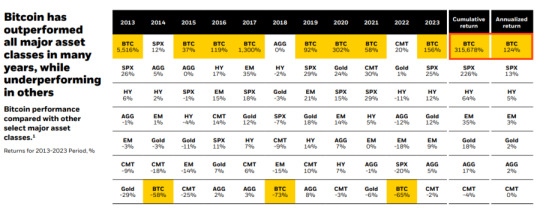
Image source: ishares.com.pdf
Ten Key Tips To Know Before Investing In Crypto
#1. Exchanges
First and foremost, it's important to understand the various types of exchanges, platforms, and products available that offer crypto. Exchange-traded funds (ETFs) have recently gained popularity, providing crypto exposure and a secure and regulated way to invest in cryptocurrency. However, ETFs and similar products face three main issues.
One concern is that their trading hours are limited to regular stock market hours, unlike the continuous 24/7 trading of cryptocurrencies. As a result, there may be discrepancies in pricing between the ETFs and the actual assets, as well as challenges in entering or exiting positions before significant price fluctuations occur.
Another issue is that they do not permit you to possess the actual asset outright. In cryptocurrency, taking custody of your own funds is typical among seasoned investors. While the self-custody approach may not suit everyone and carries its own set of risks, the advantage is that it removes the counterparty risk associated with ETFs.
The third issue is the limited availability of exchange-traded products that allow investors to invest in altcoins, which are cryptocurrencies other than Bitcoin. While some investors may be content with Bitcoin (BTC) exposure, others seek opportunities in alternative cryptocurrencies that offer the potential for significantly higher returns, ranging from 10 to 100 times.

Image source: Investopedia
#2. Volatility
Before investing in cryptocurrency, it's crucial to understand that prices can fluctuate rapidly and unpredictably, especially for alternative coins. Price swings of 10% or more in a short period are common for Bitcoin, while altcoins can experience even more significant fluctuations, with price changes of 20% or more in minutes. This high level of volatility can be stressful and may lead to impulsive decisions based on emotions rather than sound investment strategies. Consequently, many investors tend to buy during strong market upswings and sell during sudden downturns.
Cryptocurrencies experience significant price fluctuations primarily due to their speculative nature. The main reason behind this volatility is that cryptocurrencies are designed to challenge and potentially replace traditional financial systems. Each crypto project aims to address specific aspects of the financial system. Tokens that provide real-world utility within a particular niche may be less speculative.
An additional factor that plays a role is the significant use of leverage trading within the cryptocurrency environment. During bearish periods, minor price declines can snowball into substantial crashes as leveraged traders are forced to liquidate their positions, while in bullish markets, small price increases can rapidly escalate into massive price surges as leveraged traders scramble to maintain their positions.
Fortunately, two strategies can help mitigate the impact of volatility in cryptocurrency trading. Firstly, investing in cryptocurrencies with a larger market cap can provide a lower-risk option, as they tend to experience less price fluctuation than smaller-cap cryptocurrencies. However, this stability comes at the cost of potentially lower returns. Secondly, traders can reduce their exposure to volatility by using less leverage or setting stop losses at prudent levels, informed by technical analysis. Being knowledgeable about chart patterns and trends can aid in making informed decisions.
#3. Categories of Cryptocurrencies
This relates to the third essential aspect to consider before investing in cryptocurrency. It is crucial to understand that not all cryptocurrencies are the same. Generally, there are two main categories of cryptocurrencies – coins and tokens. Coins are digital currencies utilized to cover transaction costs within their respective blockchain networks, like BTC within the Bitcoin blockchain. On the other hand, tokens are digital assets that can be created through smart contracts on specific cryptocurrency blockchains, such as Ethereum or Solana.
The value of coins is typically tied to the blockchain they are a part of. In contrast, tokens often derive value from their usefulness or utility within a specific decentralized application (dApp) or protocol. This distinction is noteworthy because coins tend to perform better than tokens in the cryptocurrency market, likely due to the greater level of effort and investment required to create a new blockchain from scratch.
It is possible for anyone to generate a cryptocurrency token quickly using specific decentralized applications. This has led to a proliferation of tokens, with millions available, while only a select few cryptocurrency coins have gained widespread recognition and utility. Most tokens lack practical use or value, whereas those that serve a purpose tend to exhibit more significant potential for success.
The success of a coin or token is ultimately determined by the narrative it's associated with. Take Bitcoin's BTC, for instance, which is widely regarded as the digital equivalent of gold. This narrative is just one of many that can impact price movements. This article delves into other significant narratives that can shape the performance of coins and tokens.
#4. Quality Information
Finding reliable information about cryptocurrency projects can be a significant challenge. This is due to a shortage of educational resources, the intricate nature of most crypto projects, and a general lack of information available. As a result, it can take time and effort to make informed investment decisions in the cryptocurrency market.
The lack of understanding surrounding cryptocurrency has led to significant financial losses for many investors. Many have sought to solve this issue through online publications and transparent crypto platforms’ blogs and videos, which aim to educate the public about the nature of cryptocurrency and the scams that have plagued the industry conceived by nefarious opportunists seeking to exploit others' ignorance.
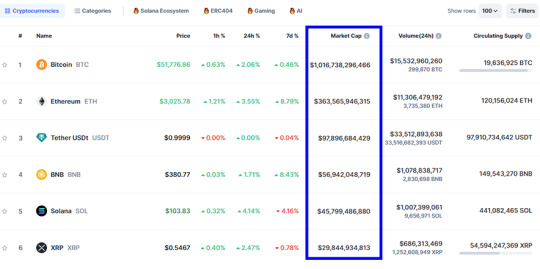
Image source: Coinmarketcap
#5. Market Cap
Before investing in cryptocurrency, it's essential to understand the distinction between a crypto's market cap and its price. Many people assume that a crypto's price determines its potential for growth, but in reality, the market capitalization holds greater significance. Many first-time investors in the cryptocurrency market are unaware of this fact. Consequently, some cryptocurrencies with lower price tags tend to perform better than those with higher price tags.
This is because new investors often assume that a low-priced cryptocurrency has more room for growth and will eventually reach the same level as Bitcoin, making them rich in the process. Practically speaking, it is essential to consider both the price tag, which is attractive to new and inexperienced investors, and the market cap, as it ultimately influences a cryptocurrency's potential increase or decrease in percentage terms.
You can gauge the potential growth of a coin or token by comparing it to more established cryptocurrencies within the same niche or category and observing their growth during previous market upswings. Setting realistic expectations and understanding that smaller-cap assets are unlikely to surpass the dominance of BTC or ETH in the foreseeable future is essential.
#6. Self Custody
Before investing in cryptocurrency, it's crucial to understand the importance of self-custody. In the crypto space, a famous saying goes, "Not your keys, not your crypto." This means that if you don't possess the private keys to your crypto wallet, you don't truly own the cryptocurrency inside it. Self-custody is crucial because it ensures that you have complete control over your digital assets and that they're securely stored in a wallet that only you can access.
So, if you're not given a 12 or 24-word seed phrase, also known as a private key, when creating an account and are required to copy and secure that key in a safe place, you're likely using a custodial service. In other words, your cryptocurrency is being held by a third party, similar to how a bank holds your money. Interestingly, the money in your bank doesn't technically belong to you either, as explained in this article.
It is essential to take control of your own cryptocurrency to achieve true financial independence, which means having the freedom to use your assets as you please and when you please. You need to establish a cryptocurrency wallet and consistently store the coins or tokens you are not currently trading in that wallet.
Cryptocurrency wallets come in various forms, including mobile, browser, and desktop versions. However, a hardware wallet is advised for optimal security, especially for significant crypto holdings. This physical device allows you to store your cryptocurrency offline, providing additional protection.
#7. Portfolio Diversification
Creating a diversified crypto portfolio is an important consideration before investing in cryptocurrency. While all coins and tokens are part of the crypto market, it is essential to understand that they come with different levels of risk, rewards, and utility.
Bitcoin’s BTC is viewed as a secure investment haven within the cryptocurrency sector. During market downturns, investors often flock to BTC as a safe haven, causing its value to increase. On the other hand, when the markets are thriving, investors tend to move their funds from BTC into more speculative cryptos, starting with Ethereum (ETH) and then to other smaller cryptocurrencies down the list.
Furthermore, stablecoins, which are cryptocurrencies supported by and pegged to traditional currencies, particularly the US dollar, are also considered safe options during times of turbulence in the cryptocurrency market. However, not all stablecoins are created equal, and some are considered safer than others due to their unique characteristics and uses.
A diversified cryptocurrency portfolio should include a mix of established large-cap assets, mid-sized coins with growth potential, and a few small-cap projects with promising futures. It's crucial to avoid over-investing in too many cryptocurrencies, as managing and tracking their performance can become challenging. Instead, focus on gaining exposure to a range of narratives that are likely to drive the next bull market in the crypto space.

Image source: Cwallet.com
#8. Time Horizon
Before investing in crypto, it's essential to consider your investment time frame, and this is closely related to the seventh factor. Cryptocurrency markets tend to fluctuate in a predictable four-year cycle, with the first one to two years typically experiencing a bull market, followed by a bear market during the final two to three years. Understanding this pattern can help you make informed investment decisions and maximize your returns.
These crypto cycles are believed to be influenced by the Bitcoin halving event, which occurs every four years and involves reducing the number of BTC coins given to Bitcoin miners by half. The next halving is anticipated to take place in April 2024.
The cryptocurrency market has traditionally experienced a significant upswing a few months following the halving event. If history is any guide, the next bull run is expected to begin around August or shortly after that, with Bitcoin and most alternative coins reaching new record highs during this time. However, it's important to note that the peak of this cycle may not occur until mid to late 2025, according to recent reports.
If you have been investing in cryptocurrencies before the market reaches its peak frenzy, you will likely see significant profits when it reaches its highest point. Surprisingly, you may not feel inclined to sell your holdings at that point.
As highlighted in the introduction, Crypto has emerged as the best-performing investment category in the past ten years. Retaining and building up significant amounts of well-known cryptocurrencies, such as BTC, during various market fluctuations would have yielded more significant profits than selling them.
This emphasizes that your personal time frame is the key consideration. If you aim for significant profits in the short term, it's advisable to align with the four-year pattern. Yet, if your goal is long-term wealth accumulation, it may be wiser to focus on steady accumulation without overanalyzing the process.
#9. HODL
The ninth key fact to consider before investing in cryptocurrency is that only two assets have consistently outperformed inflation over the past few decades: technology and finance. Notably, cryptocurrency represents a fusion of these two domains and boasts a unique advantage – it cannot be seized or confiscated. This attribute contributes to its value and potential for long-term growth.
This statement applies only to genuinely decentralized cryptocurrencies, as only those can uphold these characteristics. Bitcoin's BTC is considered the most decentralized cryptocurrency, serving as a safeguard or hedge against the entire existing financial system.
Considering the unpredictability of the financial system, it's a good idea to diversify your investments and protect your wealth in case of uncertainty. One way to do this is by investing in an asset that can't be easily seized, such as Bitcoin. Unlike gold, which requires physical storage and security, Bitcoin can be readily stored and transferred using just a seed phrase, which can be memorized for added convenience.
It’s salient to note here that every Bitcoin transaction is recorded on a public ledger and, therefore, is traceable. This transparency can concern individuals who want to distance themselves from the traditional financial system. However, despite this limitation, Bitcoin remains a viable alternative to conventional currencies, apart from gold, particularly for those who value freedom and decentralization.
For emphasis, the notion that central banks aspire to establish a financial system characterized by universal surveillance and control is not a far-fetched conspiracy theory. In fact, various reports have been published explicitly outlining such intentions. This system would enable comprehensive monitoring of all assets, ensuring that every item of value is accounted for and exists within a network that central authorities govern.
In any case, while it may be thrilling to consider the potential earnings in cryptocurrency, it's crucial to bear in mind that preserving these funds could prove challenging if the financial landscape follows its current path. Securing a portion of these profits in a tangible asset for long-term stability is prudent.

Image source: X
#10. Scams
It is crucial to be aware that the world of cryptocurrency investing is rife with scams. The various factors discussed earlier create an environment where misinformation about crypto is prevalent and highly persuasive. Deceptive practices can take the form of fraudulent airdrops and giveaways, with the latter becoming increasingly widespread due to advancements in deep fake technology.
Fraudulent accounts posing as well-known figures in the cryptocurrency space are widespread during periods of market growth. Trying to report or remove all of their comments is futile, and it's crucial to exercise caution when engaging with unsolicited messages or investment opportunities.
A general guideline is to be cautious of offers that seem too good to be true because they likely are. Additionally, any direct message claiming to be from a prominent crypto personality should be met with skepticism. When interacting with decentralized applications and protocols, it's essential to do your due diligence to avoid losing funds. Finally, storing any coins or tokens not currently being traded on a secure hardware wallet is vital to protect them from potential threats.
This article is provided for informational purposes only. It is not offered or intended to be used as legal, tax, investment, financial, or other advice.


Editor and Chief Markethive: Deb Williams. (Australia) I thrive on progress and champion freedom of speech. I embrace "Change" with a passion, and my purpose in life is to enlighten people to accept and move forward with enthusiasm. Find me at my Markethive Profile Page | My Twitter Account | and my LinkedIn Profile.
0 notes
Photo

New Post has been published on http://cryptonewsuniverse.com/which-crypto-narratives-will-dominate-the-next-bull-market-cryptos-to-watch-in-2024/
Which Crypto Narratives Will Dominate The Next Bull Market? Cryptos To Watch In 2024


Which Crypto Narratives Will Dominate The Next Bull Market? Cryptos To Watch In 2024

The key to achieving success in the cryptocurrency realm is to invest in narratives, not just statistics. During the previous bull market, the most captivating narratives were Decentralized Finance (DeFi), Non-Fungible Tokens (NFTs), and the Metaverse. These narratives propelled certain cryptocurrencies to astronomical heights, with some experiencing growth of over 500 times their original value. The question now is what narratives will dominate the next crypto bull market and when they will experience a similar explosion in growth.
These projections are provided by key figures in the cryptocurrency industry and should be taken as speculative. This article focuses on the key narratives likely to shape the cryptocurrency landscape, their anticipated increase in popularity, and the projects linked to them that are worth keeping an eye on. The ongoing development of crypto regulations will largely influence the sequence in which these narratives gain prominence.
The rise of decentralized finance (DeFi) was a dominant force in the 2020 crypto bull market, with DeFi tokens experiencing remarkable growth, including Yearn Finance's YFI token, which at one point surpassed the value of Bitcoin. However, recent regulatory proposals aimed at DeFi suggest it may not be the dominant narrative in the current market cycle. Instead, other crypto narratives with fewer DeFi elements may gain more traction.
The success of crypto narratives may depend on the regulatory landscape, but some experts suggest that those with minimal DeFi integrations will have an advantage. This is because they will face fewer regulatory obstacles and enjoy greater adoption. Non-fungible tokens (NFTs) are the crypto technology with the least regulatory scrutiny, making it likely that narratives centered around NFTs will dominate.
Crypto Narratives Most Likely To Explode
Decentralized Social Media
The rise of decentralized social media (DESO) is anticipated to gain significant traction thanks to a convergence of factors. Growing censorship on traditional social media platforms, potential failures of popular networks, and challenges with monetization in a high-interest-rate environment have created an opportune landscape for DESO's growth. Governments worldwide have implemented laws to restrict social media content following the impact of the pandemic, as highlighted in this article on online censorship.
The implementation of various regulations, including the Digital Services Act (DSA) of the European Union, is causing a noticeable impact. Consequently, engaging in open and unrestricted conversations on major social media platforms is becoming increasingly challenging. An example of one leading social media platform, such as X, is now prioritizing free speech. Unfortunately, the resistance by these platforms may lead to their eventual downfall. X, for instance, has recently lost advertisers and is expected to incur significant financial losses.
The supposed economic downturn has led to a universal decrease in advertising revenue. In response, Google has taken measures to restrict the use of ad blockers on YouTube and has increased the frequency of advertisements in an effort to boost its ad revenue.
Upon initial consideration, it may appear improbable that the typical individual would transition to utilizing a decentralized social media platform due to concerns regarding censorship and advertisements. Nevertheless, upon further examination, it becomes evident that the adoption of decentralized social media is gaining momentum, with decentralized streaming experiencing remarkably rapid growth, as illustrated in the graph below.
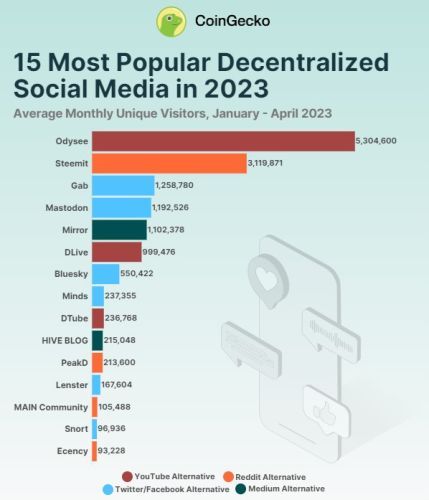
Image source: Coingecko
Put in perspective, Odysee boasts a substantial user base exceeding 5 million individuals monthly, which continues to grow. As a decentralized social media protocol, Odysee outshines its competitors significantly. It is worth noting that Odysee is powered by LBRY, a cryptocurrency initiative that faced legal action from the SEC and was subsequently forced to cease operations. Nevertheless, Odysee remains the most prized possession of LBRY, Inc.
Odysee’s assets were recently sold at auction. According to LBRY’s report, while it’s nearly certain the Odysee assets will be assumed by someone interested in resuming its growth, it’s unclear if Odysee will continue to use the LBRY network in the future, switch to another crypto network, or switch to being a traditional web2 platform.
If another crypto network acquires Odysee, you can bet that the crypto project will see explosive growth. Additionally, there is growing interest in decentralized platforms that replicate the functionality of traditional social media platforms like Twitter, as shown in the graph. These platforms concentrate on specific aspects of digital media, such as decentralized streaming and microblogging, and are designed to operate vertically.
One decentralized platform that is not on that list yet encompasses all of the above and more. Markethive and its community are dedicated to building an entire ecosystem for entrepreneurs, including marketing, blogging, curation, email autoresponders, page-making systems, video feed, conference facilities, e-commerce, broadcasting, press releases, social network integration, etc.
Having established a comprehensive financial center for all its users and utilizing the Solana network for its Hivecoin token, Markethive is now preparing to introduce its platform to a global audience. Markethive has also removed itself from the centralized cloud services that continue to stifle platforms at the mercy of third-party APIs serving their interests. Currently, several user interface (UI) and UX components of Markethive's arsenal are being integrated in tandem to provide a sanctuary and empower individuals to regain control of their sovereignty. This year, 2024, is shaping up to be a pivotal time for Markethive, as it aims to reach unparalleled success and give back to the community that has embraced its vision.
GameFi
GameFi, the second prominent crypto narrative, is poised to experience immense growth, with some arguing that it's already underway. A glance at DappRadar reveals that the majority of the most well-liked decentralized applications (dApps) are connected to blockchain-based games. These games have amassed a considerable following, boasting millions of monthly active users. The surging popularity of blockchain games shouldn't come as a surprise, given that the traditional gaming industry grapples with challenges akin to those confronting centralized social media platforms.
To begin with, it seems that older video games are preferred over modern ones. This can be attributed to a variety of factors, such as disappointing visuals, weak storytelling, unnecessary infusion of politics, and overall unsatisfactory gameplay.
In 2022, the video game industry experienced its first year of losses in ten years, resulting in widespread layoffs among major developers. This downturn may be attributed to the pandemic-driven surge turning into a decline or developers ignoring their loyal player base. Regardless of the cause, the gaming industry is struggling financially. Similar to other technology leaders like Google, this situation may motivate game developers to explore alternative revenue streams.
Interestingly, it has been reported that players of Assassin's Creed encountered disruptive pop-up advertisements while playing the game. This occurrence was purportedly a technical glitch, but it shed light on the possibility that the gaming industry is attempting to impose advertisements on players in a similar manner to how YouTube is attempting to do so with its audience. While the typical YouTube viewer might tolerate this, it is highly probable that the average gamer would not welcome having their gameplay disrupted by pop-ups.
The outcome may be that game developers must incorporate GameFi elements to compensate for lost revenue, or players will seek out ad-free alternatives. A mixture of both scenarios will probably occur, which could be why blockchain games have gained significant popularity. If it is indeed the case that game developers are disregarding their primary audiences, then the adoption of blockchain games could even further increase.
This is because crypto technology, such as NFTs, enables gamers to influence the game's design instead of being controlled by ESG-obsessed asset managers like BlackRock. However, there is a limitation: these blockchain games must not involve excessive financialization. If they do, they may attract regulatory scrutiny, similar to what happened to Axi Infiniti in the Philippines.
The likelihood of this scrutiny is likely the reason why there have been limited GameFi integrations. Aside from regulatory hurdles, scalability and speed pose a significant challenge to widespread adoption, as seen in the case of Axi Infinity. Only a few blockchains can effectively accommodate millions of users simultaneously.
In Axi's situation, they had to develop their specialized layer two solution called Ronan. This implies that you should prioritize the underlying layer one and layer two blockchains that support blockchain games rather than focusing on specific games. Thanks to its subnet architecture, Avalanche is notably gaining popularity as a preferred choice in this area.
Artificial Intelligence (AI)
The emergence of Artificial Intelligence (AI) as a dominant force in the tech industry is a narrative that has gained significant traction recently. While some argue that the AI explosion is already underway, others believe the real breakthrough is yet to come. The current AI hype in crypto and stocks is largely considered just hype, as there have been minimal actual changes thus far. It is widely believed that it will take at least two years for innovative AI companies to release their products and even longer for the general public to embrace and utilize them fully.
The current AI-fueled market frenzy may eventually subside as regulatory measures take effect or other factors come into play. If this bubble does burst, it may create a prime investment opportunity for crypto projects centered around AI technology. These projects will likely perform exceptionally well when the AI narrative regains momentum. Currently, everyday investors like us are unable to capitalize on AI innovation, making these cryptocurrency projects an attractive prospect.
While investing in established companies like Nvidia and Microsoft is possible, their massive valuations limit their potential for significant growth. As a result, private equity remains the most viable option for those seeking substantial returns on AI investments – but this avenue is only accessible to high-net-worth individuals. If this trend persists, investing in AI-related cryptocurrencies might be the only way for everyday investors to generate meaningful profits from the AI sector.
The emergence of new AI companies may be hindered if industry leaders such as Nvidia and Microsoft restrict access to their hardware and software. However, crypto tech's decentralized and open nature could provide an advantage in this scenario. Interestingly, some crypto projects have enabled individuals to access the previously exclusive hardware needed to run AI models, thereby promoting greater accessibility and competition in the field.
Among the projects in this category is the Akash Network. Additionally, numerous cryptocurrency initiatives have been making advancements in the software aspect of artificial intelligence. By merging this open-source progress with decentralized AI hardware, the result is a foundation for robust crypto AIs capable of rivaling those developed by Google and other companies.
In this instance, the main point to note is that if crypto AI were to become popular, the existing players would probably try to influence government regulators in order to prevent the development of decentralized artificial intelligence technology. It is important to note that these incumbents are already campaigning for policies that would hinder their centralized rivals from creating AI technology.
The upside is that AI in the crypto sector is still largely under the radar. This means there aren't many established factors to consider when evaluating its potential. Nobody knows yet whether the crypto industry can support the development of these models. Nevertheless, just as no one anticipated Bitcoin becoming the de facto digital gold, we find ourselves in that very situation. This demonstrates the potential for unexpected developments in the crypto landscape.
Crypto Infrastructure
Infrastructure in the crypto industry is expected to experience significant growth, particularly in the areas of decentralized storage cryptocurrencies and crypto oracles that provide external data to the blockchain. It is important to note that infrastructure cryptos will play a crucial role in the success of other crypto narratives. For example, decentralized social media will likely demand substantial data storage capacity, while decentralized gaming will rely on extensive data feeds. Additionally, crypto AI will heavily rely on decentralized computing, which differs from decentralized storage regarding technical requirements.
Data storage, data feeds, and computing processes must be decentralized to ensure seamless operation and avoid potential regulatory or technical issues. This is particularly important given that a prominent centralized cloud platform banned crypto in August 2022. Moreover, Meta's use of Arweave for NFT storage demonstrates that decentralized infrastructure can be just as effective as its centralized counterpart. If discriminatory practices persist at the infrastructure level, such as app stores refusing to list certain apps, decentralized alternatives are likely to gain traction
In addition to Arweave, other cryptocurrencies worth keeping an eye on include cutting-edge oracle systems like Pyth, which may have a role in the gaming sector (GameFi); video encoding protocols such as Livepeer, which could have a role in decentralized social networks (DeSo); and data indexing protocols like The Graph, which could have a role in artificial intelligence (AI) development. It's important to note that this list is not exhaustive, and there may be other promising cryptocurrencies beyond these examples.
The level of adoption of the three previous narratives will influence the demand for these cryptocurrencies and their competitors. If there is significant adoption, there will be ample demand for these cryptos, potentially leading to an increase in price. However, it is essential to conduct thorough research on the tokenomics of these cryptocurrencies before investing, as this will determine whether the demand translates into a price surge.

Image source: Techopedia
Two More Narratives with Potential
Concluding the discussion, two additional crypto narratives may grow significantly. These narratives can potentially surpass the combined impact of the previous four. The first is the concept of crypto payments, while the second is the tokenization of real-world assets (RWAs), which has recently generated much hype. These two narratives are presented together as the final topics in this article due to the numerous regulatory challenges they face, specifically in the case of RWAs for crypto payments.
One of the main challenges involves the regulations surrounding stablecoins, which remain uncertain in numerous jurisdictions, especially in the United States. Congress is currently considering a proposed bill that could facilitate the use of stablecoins for payments, but its passage is unlikely until after the upcoming election due to the political divisions within the legislative body.
In the European Union, the Markets In Crypto Assets (MiCa) regulation technically allows stablecoins to be used for payments. However, the use of stablecoins will be restricted to Euro-backed stablecoins, which some argue are not all that popular. Despite this, regulatory clarity could lead to the adoption of crypto payments, positively impacting high-performance blockchains primed for payments, such as Solana and layer two solutions on Ethereum.
This relates to the regulations around RWAs, which are much further away. Some would say that this is debatable, given that stablecoins are technically RWAs; there are already tokenized fiat currencies and commodities. However, some argue that these differ from the RWAs on which the narrative truly focuses. The RWAs that most people have in mind involve tokenizing assets such as real estate, stocks, and bonds. If this is the situation, then tokenizing these assets on public blockchains is a distant prospect.
Significantly, major organizations and wealthy individuals would likely feel uneasy about revealing their RWA assets on transparent blockchains accessible to the public. As a result, they would opt for private and permissioned blockchains or public blockchains that ensure compliant privacy. When considering this, the transparency of cryptocurrency blockchains could pose a major challenge for narratives centered around institutional interests such as RWAs, which is why we're seeing growing interest in crypto privacy solutions. However, this particular market segment may not experience significant growth until the next cycle; it's an area that holds promise for the future.
This article is provided for informational purposes only. It is not offered or intended to be used as legal, tax, investment, financial, or other advice.


Editor and Chief Markethive: Deb Williams. (Australia) I thrive on progress and champion freedom of speech. I embrace "Change" with a passion, and my purpose in life is to enlighten people to accept and move forward with enthusiasm. Find me at my Markethive Profile Page | My Twitter Account | and my LinkedIn Profile.
0 notes
Photo

New Post has been published on http://cryptonewsuniverse.com/how-inbound-marketing-fuels-disruptive-innovation-a-guide-for-forward-thinking-entrepreneurs/
How Inbound Marketing Fuels Disruptive Innovation: A Guide for Forward-Thinking Entrepreneurs


How Inbound Marketing Fuels Disruptive Innovation: A Guide for Forward-Thinking Entrepreneurs

In today's fast-paced and rapidly evolving business landscape, traditional marketing strategies are no longer sufficient to drive innovation. To stay ahead of the curve, forward-thinking businesses turn to inbound marketing as a powerful tool to fuel disruptive innovation. In this guide, we will explore the concept of inbound marketing, its role in fostering disruptive innovation, and the benefits it offers to entrepreneurs.
Inbound marketing is a strategic approach focusing on attracting, engaging, and delighting customers through valuable content and experiences. Unlike traditional outbound marketing, which relies on interruptive tactics like cold calling and advertising, inbound marketing aims to build long-term relationships with customers by providing them with relevant and helpful information. By leveraging content marketing, social media, and search engine optimization (SEO), inbound marketing creates a magnet-like effect, organically drawing customers to your business.
Understanding Disruptive Innovation
To understand how inbound marketing fuels disruptive innovation, we must first grasp the concept of disruptive innovation itself. Disruptive innovation refers to the process by which a new product or service disrupts an existing market by offering a unique value proposition. This innovation often starts at the fringes of the market, targeting underserved customers with a novel solution that addresses their unmet needs.
Disruptive innovation challenges the status quo, and forces established players to adapt or risk becoming obsolete. Examples of disruptive innovations include the advent of smartphones, which revolutionized the telecommunications industry, and online streaming services, which disrupted the traditional television and movie rental market. By leveraging inbound marketing, businesses can identify and capitalize on disruptive innovations that have the potential to shape the future.
Now, here's where inbound marketing steps in. Businesses can spot these disruptive innovations early on by using inbound marketing techniques, like creating engaging content or building strong relationships with potential customers. This means they can get in on the action and take advantage of these groundbreaking ideas before they become mainstream.
So, inbound marketing isn't just about attracting customers—it's also about staying ahead of the curve and spotting the next big thing that could shape the future.

The Role of Inbound Marketing in Fueling Disruptive Innovation
Inbound marketing is like the fuel for those game-changing, disruptive ideas. It gives them a stage to shine on and get noticed. Imagine you've got this amazing new solution to a problem nobody's really tackled yet. Inbound marketing helps you get the word out in a way that grabs people's attention.
First, you create content that speaks to the folks who are feeling the pain of that problem you're solving. This content pulls them in because it's all about their struggles and how your solution can improve their lives. So, those early adopters who are always eager to try something new are drawn to what you're offering.
Then, you've got this storytelling magic. You're not just selling a product; you're telling a story about how it can change lives. That storytelling creates a buzz, gets people talking, and excites them about what you're doing.
But it's not just about getting attention; it's about learning too. With inbound marketing, you're not just shouting into the void. You're having conversations with real people, your potential customers, on social media and other digital platforms. And those conversations? They're gold mines of information. You get to hear directly from the people you want to serve, understanding their needs and preferences better than ever before.
And here's the kicker: You can take all that feedback and use it to improve your idea. It's like having a direct line to your customers' brains. You tweak and refine your solution based on what they tell you, making it even more tailored to their needs. And that, my friend, increases your chances of hitting it big with your disruptive innovation.
Benefits of Using Inbound Marketing for Businesses
Businesses that embrace inbound marketing as a strategy to fuel disruptive innovation stand to gain numerous benefits. Firstly, inbound marketing provides a cost-effective alternative to traditional marketing methods. By focusing on creating valuable content and leveraging digital channels, businesses can reach their target audience at a fraction of the cost of conventional advertising. This is particularly advantageous for startups and early-stage ventures with limited marketing budgets.
Secondly, inbound marketing allows businesses to build a brand that resonates with their target audience. By consistently delivering valuable content and engaging with customers, companies can establish themselves as thought leaders and gain credibility in their respective industries. This brand equity not only attracts customers but also attracts potential partners, collaborators, and talent who align with the investor's vision for disruptive innovation.
Lastly, inbound marketing offers a long-term and sustainable approach to customer acquisition. By nurturing leads through valuable content and personalized experiences, businesses can build a loyal customer base that continues to support their disruptive innovations. This customer-centric approach fosters customer loyalty and advocacy, driving organic growth and reducing reliance on costly customer acquisition strategies.
Case Studies of Successful Disruptive Innovations Fueled by Inbound Marketing
TESLA
To illustrate the power of inbound marketing in fueling disruptive innovation, let's explore some real-world case studies. One such example is the electric vehicle manufacturer Tesla. Through their innovative electric cars and sustainable energy solutions, Tesla disrupted the automotive industry. By leveraging inbound marketing strategies through unconventional marketing strategies, Tesla created a passionate community of early adopters who championed their mission and helped propel the company to success.
Tesla is known for its innovative and unconventional marketing strategies that rely on creating an emotional connection with its audience and strengthening its brand presence. Tesla does not use traditional paid advertising but instead focuses on word-of-mouth, social media, influencer partnerships, and launch events to generate buzz and awareness. Tesla also leverages the popularity and influence of its CEO, Elon Musk, who often engages with his followers and fans on various platforms.
Tesla’s marketing strategy can be considered a form of inbound marketing, which is a method of attracting, engaging, and delighting customers by providing valuable and relevant content and experiences. Inbound marketing aims to build trust and loyalty with the audience rather than interrupting them with unwanted ads. Tesla’s marketing strategy is aligned with its mission and vision of creating a sustainable, clean-energy future.
AIRBNB
Airbnb shook up the traditional hotel industry by revolutionizing how people find places to stay when they travel. Instead of relying solely on hotels, Airbnb introduced a platform where regular folks could rent their homes or spare rooms to travelers. This concept opened up a whole new world of accommodation options, giving travelers a chance to experience local neighborhoods and immerse themselves in the culture of their destination.
One of the keys to Airbnb's success was harnessing the power of user-generated content (UGC). By allowing users to post reviews, photos, and stories about their stays, Airbnb built a sense of trust and transparency lacking in the traditional hotel booking process. People could see real-life experiences from other travelers, helping them make more informed decisions about where to stay.
Through clever inbound marketing strategies, Airbnb was able to spread the word about its platform and attract both hosts and guests. They leveraged partnerships to reach a broad audience and establish themselves as a trusted brand in the travel industry.
You can see how Airbnb's innovative approach to accommodation has transformed how people travel and opened up new opportunities for hosts and guests. By tapping into the sharing economy and prioritizing user-generated content, Airbnb has become a powerhouse in the travel industry, changing how people think about where they stay when they're away from home.
These case studies demonstrate how inbound marketing can drive awareness, generate excitement, and build a loyal customer base for disruptive innovations.
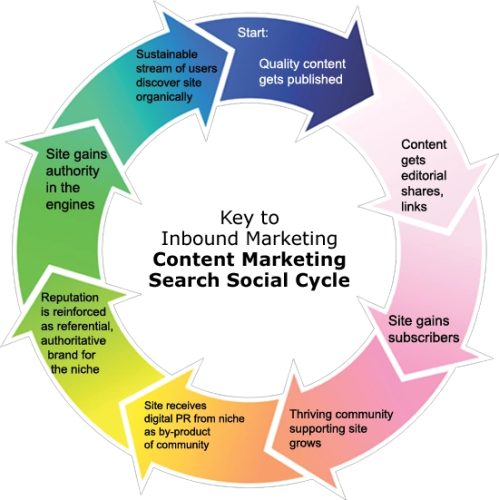
How to Implement Inbound Marketing Strategies for Your Business
Now that we understand the importance of inbound marketing in fueling disruptive innovation let's explore how businesses can implement these strategies effectively. Firstly, defining your target audience and understanding their pain points and needs is crucial. This will enable you to create valuable content that resonates with your audience and establishes your expertise in the field of disruptive innovation.
Next, develop a content marketing strategy that aligns with your target audience's preferences and habits. This may involve creating blog posts, videos, podcasts, or other types of content that provide insights, thought leadership, and solutions to their challenges. Distribute this content through various channels, such as your website, social media platforms, and industry publications, to maximize its reach and impact.
In addition to content marketing, leverage social media platforms to engage with your audience and build relationships. Actively participate in relevant industry discussions, respond to comments and inquiries, and share valuable insights. Being present and active on social media can establish yourself as a trusted resource and attract a community of like-minded individuals passionate about disruptive innovation.
Leveraging Markethive for Inbound Marketing in Disruptive Innovation
One powerful tool that businesses can leverage for inbound marketing in disruptive innovation is Markethive. Here at Markethive, we have built a comprehensive inbound marketing platform that provides a suite of tools and resources to help businesses attract, engage, and nurture leads. With content marketing, social media integration, and lead management features, Markethive empowers enterprises to implement inbound marketing strategies effectively and efficiently.
Markethive's intuitive interface and user-friendly features make it accessible to businesses of all levels of experience. Whether you are a seasoned business or just starting out, Markethive provides the tools you need to build a dynamic online presence and drive disruptive innovation.
Inbound marketing is a powerful strategy that aligns with the principles of disruptive innovation. This kind of marketing does not rely on interrupting or annoying customers with unwanted ads or messages but rather on earning their trust and loyalty by providing helpful information and experiences. Inbound marketing also enables businesses to measure and optimize their performance based on customer data and feedback.
Markethive leverages inbound marketing to create a gigantic and disruptive inbound marketing ecosystem. Markethive offers tools and services that empower entrepreneurs, businesses, and organizations to generate leads, build relationships, and grow their brands online. Markethive's ecosystem includes a social network, a blogging platform, an email marketing system, a video hosting service, a webinar service, a CRM system, a marketplace, and more. Markethive's ecosystem is designed to be accessible, affordable, and scalable for anyone who wants to benefit from the power of inbound marketing. Markethive's ecosystem is also driven by blockchain technology, which ensures security, transparency, and decentralization.
By using inbound marketing, Markethive is disrupting the traditional outbound marketing industry, dominated by expensive and ineffective advertising platforms. Markethive is creating a new paradigm of marketing that is customer-centric, value-driven, and innovation-oriented. Markethive is building not only a gigantic and disruptive inbound marketing ecosystem but also a community of like-minded entrepreneurs who share a vision of changing the world for the better.

Measuring the Success of Inbound Marketing in Fueling Disruptive Innovation
To assess the effectiveness of inbound marketing in driving disruptive innovation, it's essential to set up key performance indicators (KPIs) and track relevant metrics. These indicators help measure various aspects of inbound marketing efforts and their impact on innovation within a business.
One crucial metric to monitor is website traffic. This includes tracking the number of visitors to the company's website over time. Increased website traffic can indicate successful inbound marketing efforts, as it suggests that more people are discovering and engaging with the brand online.
Lead conversion rates are another important KPI to consider. This metric measures the percentage of website visitors who take a desired action, such as signing up for a newsletter or requesting more information. Higher conversion rates suggest that the inbound marketing strategies effectively capture potential customers' interest and prompt them to take action.
Social media engagement is also vital in evaluating the effectiveness of inbound marketing. This includes metrics such as likes, shares, comments, and retweets on social media platforms. A high level of engagement indicates that the content being shared resonates with the audience and encourages interaction, which can lead to increased brand awareness and loyalty.
Customer retention rates provide insight into the long-term impact of inbound marketing efforts. By tracking the percentage of customers who continue to purchase from the company over time, businesses can assess the effectiveness of their marketing strategies in building lasting relationships with customers.
Regularly monitoring these metrics and analyzing the data allows businesses to gain valuable insights into the performance of their inbound marketing strategies. By identifying areas of strength and areas for improvement, companies can make informed decisions to optimize their marketing efforts and drive continuous innovation within their organization.
Conclusion and Key Takeaways
Inbound marketing has emerged as a powerful tool for forward-thinking businesses looking to fuel disruptive innovation. By attracting, engaging, and delighting customers through valuable content and experiences, inbound marketing creates a platform for disruptive ideas to gain traction. Through case studies and real-world examples, we have seen how inbound marketing can drive awareness, build a loyal customer base, and ultimately transform industries.
To implement inbound marketing strategies effectively, businesses can leverage the full suite of tools in Markethive. Businesses can continually refine their strategies and drive disruptive innovation by measuring the success of their inbound marketing efforts through relevant metrics.
In conclusion, embracing inbound marketing as a strategy for fueling disruptive innovation is a wise choice for forward-thinking entrepreneurs. By leveraging the power of inbound marketing, businesses can navigate the ever-changing business landscape and stay at the forefront of disruptive innovation.


About: Prince Ibenne. (Nigeria) Prince is passionate about helping people understand the crypto-verse through his easily digestible articles. He is an enthusiastic supporter of blockchain technology and cryptocurrency. Find me at my Markethive Profile Page | My Twitter Account | and my LinkedIn Profile.
0 notes
Photo

New Post has been published on http://cryptonewsuniverse.com/understanding-the-cryptocurrency-token-and-network-equity-within-markethive-and-beyond/
Understanding The Cryptocurrency Token and Network Equity within Markethive and Beyond


Understanding The Cryptocurrency Token and Network Equity Within The Markethive Ecosystem And Beyond

Since the inception of Bitcoin, it has been regarded as the trailblazer and the gold standard of the cryptocurrency realm. Its influence extends beyond being a digital store of value, as it is often used as a reference point for other digital assets in the crypto finance industry. The emergence of thousands of crypto tokens has led to a plethora of use cases, but the Securities and Exchange Commission's (SEC) tendency to classify most tokens as securities might be misguided, as they have not fully appreciated the groundbreaking potential of these tokens.
The concept of tokens is a foundational permutation in blockchain technology, and it is essential to explain this new concept in a way that is easy to understand. Doing so increases the likelihood that the general public, regulators, and the myriad of established entities will grasp the importance of this paradigm shift. This article aims to demonstrate the various aspects of a cryptocurrency token and why it is crucial for those in positions of authority to gain a deeper understanding.
The complexity of understanding the token stems from its nature as a multi-functional abstract. We are not accustomed to encountering something that possesses multiple functional properties, represents diverse units of value, and exists in a digital form that unifies it all. Tokens are a relatively novel concept, and if we persist in attempting to categorize or categorize them using our previous frameworks, we will miss their potential. In essence, tokens can simultaneously embody the characteristics of currency, equity, financial instruments, rewards, rights, and, since blockchain, digital assets.

Traditional Thinking
Until now, we’ve only been familiar with fragmented structures to represent each of these roles. For example;
CURRENCY: We have employed currencies such as the dollar, yen, euro, pound, and numerous other sovereign fiats for currency.
EQUITY: In the equity realm, we have shares or stock units, commonly referred to as securities.
FINANCIAL INSTRUMENTS: Regarding financial instruments, we have an array of options, such as derivatives, bonds, futures, options, swaps, and so on, which brokers, agents, custodians, or exchanges typically manage.
REWARDS: For incentives or rewards, we have various companies doling out reward points, frequent flyers, loyalty cards, and the like.
RIGHTS: For rights, we have government-issued identity cards or share proxies that enable us to participate in the governance of matters that concern us, effectively giving us a voice in decision-making processes.
However, introducing a token that combined all these facets into a single entity led to much confusion in traditional finance, corporate, private, and public arenas.
The advent of blockchain technology has created a distinct category of digital assets: non-fungible tokens. (NFTs) These tokens are unique and transferable units of value that can represent a wide range of items, including a digital artwork of a cat, such as CryptoKitties, a cartoon character, a virtual toy, or a rare in-game item.
They can also represent real-world items like concert tickets or collectibles. This classification encompasses all the possible use cases for crypto tokens, opening up new possibilities for the future of digital ownership and exchange.

The Six Roles Of A Token
Currency can be exchanged for goods and services or utilized to access computer resources associated with blockchain technology, such as Ethereum’s gas, Bitcoin’s miner fees, transaction fees, etc.
Equity signifies owning a tangible asset such as real estate or a representation of a commodity like gold.
Financial instruments encompass a wide range of financial services products, both existing and emerging that are destined to transition to a fully digital format in the future.
Rewards are work tokens, representing a tangible outcome that can be earned through various forms of human or computer-based effort. This can include active contributions, such as completing tasks or providing services, as well as passive contributions, such as sharing valuable data or content.
A Right may encompass the ability to participate in decision-making processes such as voting (governance-related) or the ability to access resources like digital content or services that offer tangible benefits.
The Digital Asset signifies a virtual entity, an NFT (non-fungible token) within the blockchain community. These tokens are unique digital objects that exist solely in a digital format and do not have a physical counterpart.
Additionally, tokens can also have a time-based restriction, meaning their usage is limited to a specific period. They can be locked or unlocked, which determines when they can be used.
A crypto token can potentially encompass all of these functions simultaneously, or only a few of them. Alternatively, it might initially serve one purpose and evolve into others. This challenges regulators and others as they struggle to comprehend and regulate this innovative concept that exists in multiple forms concurrently, contrary to our accustomed perception of them as separate entities.
Moreover, each token can have numerous variations in its lifecycle, including creation, acquisition, purchase, sale, granting, storage, and utilization. The most crucial aspect is that these tokens can be exchanged, traded, or transferred between individuals without the need for intermediaries, fostering a seamless and decentralized process.
The token embodies the adaptable spirit of a chameleon, utilizing cutting-edge technology to shatter various barriers imposed by society, government, and commercial entities. This versatile tool condenses numerous constructs into a single, potent symbol of innovation and progress.
This leads us back to the topic of regulation. The focus on securities regulation for governing tokens is misguided. It's like trying to force a square peg into a round hole or applying a solution where it's not needed. This approach not only hinders the development of new business models but also stifles the potential of token-based innovations.
Accordingly, it is essential to acknowledge that the token represents a distinct category of assets. To succinctly describe it, we can refer to it as a novel asset class that warrants its own legal and regulatory framework. Unlike the term "security," which regulators may use to classify it, a token does not always signify a personal financial stake or equity share in a larger financial entity. Instead, it serves as a novel representation of our progressively digital existence.

William Mougayar's Blockchain Marketplace. Source: Coindesk
Tokens Create Value Through User-Generated Work
Apart from tokens, protocols, and new forms of securities, there is a broader concept at play here. This concept revolves around the work that is indirectly symbolized by the tokens and its connection to the generation of value through user interactions. In other words, it pertains to the paradigm of creating value through work.
Tokens serve as a tool to achieve a goal. User actions yield tokens, which represent their value in the digital realm. These tokens are directly tied to the worth generated by users' efforts, benefiting both the network and other users.
Social networks have long been associated with user-generated content (UGC), which refers to creating and sharing original content by users. However, as the concept evolves, it may be more accurate to refer to it as user-generated work (UGW) in order to highlight the importance of diverse user participation that yields tangible financial benefits.
Categorizing Token Functions in Three Components
1. Tokens that enable a protocol's functionality, like Bitcoin or Ethereum, are primarily utilized for software development activities carried out by the network participants.
2. Tokens that are inherent to a vertical-specific area of operation, such as Steemit, Filecoin, and Storj, are used for tasks like curating or creating content, storing files, sharing data, etc.
3. Tokens that expand existing businesses, such as loyalty points provided by established companies, have the potential to create an ecosystem that drives more transactions. We can refer to this as "hybrid models," which is the classification that Markethive belongs to.
The underlying principle is that users' behaviors and engagements within the platform create value, which in turn allows them to earn internal tokens that can be used to facilitate new transactions within the network, thereby generating further value.
⺠The tokens that are generated resemble the outcome of the user's activities.
⺠Tokens embody a multifaceted purpose, transcending their traditional role as a medium of exchange. They also serve as a measure of reputation, a reflection of engagement, a symbol of influence, and a gauge of activity within a given community or platform.
⺠Tokens serve as a representation of the economic activity occurring within the network.
⺠Acquiring tokens should be achieved honestly, not through manipulative gaming tactics.
⺠The more aligned the token is with a company's core values and business model, the greater its long-term viability will be.
⺠Value creation is aimed at various categories of individuals or customers, such as core developers, creators of applications, end-users, speculators, ecosystem collaborators, founders, buyers, sellers, readers, writers, investors, influencers, partners, and more.
The foundation of these tokenized structures is the principle that every participant is entitled to receive a portion of the total value generated through their combined efforts.
The Evolution Of Digital and Social Media
Facebook
Facebook's business model revolves around capitalizing on its users' attention and engagement, including likes, shares, posts, and comments, yet users don't receive any compensation for their contributions. If Facebook were structured as a decentralized entity with a token, users would earn tokens for their participation, which could be traded or redeemed through a liquid marketplace, both within and outside the platform.
Facebook does not engage in economic sharing. However, billions of individuals create and share content for them. Meanwhile, Facebook has been researching user data to understand how friendships on the platform are linked to economic opportunities. They have found that social connections greatly influence people's ability to secure employment, excel academically, and receive assistance in times of crisis. This behavior may harm Facebook as other business models centered around sharing network equity gain popularity.
X (formerly Twitter)
In contrast, Elon Musk's X has relaxed its censorship rules and is currently prioritizing the development of a peer-to-peer payment system. Musk envisions a platform where users can easily transfer funds to others and withdraw their money into verified bank accounts. Furthermore, there are plans to introduce a high-interest money market account to incentivize users to keep their funds within the X platform. This strategy would directly challenge PayPal's dominance in the market, as Musk aims to revolutionize the current banking system.
The payment system will also facilitate X's expansion into the creator economy, which rewards users with at least 500 followers and 5 million organic post impressions in the past three months. These users can now participate in X's Ads Revenue Sharing program, furthering the platform's commitment to empowering creators in the digital economy.
It’s yet to be determined whether the payment system will include cryptocurrency even though Musk hinted at supporting crypto on the platform, briefly switching out Twitter's bird logo to dogecoin's dog before its rebranding to X.
Markethive
Markethive understands and has embraced the concept of "Tokenization of Work" and has leveraged cryptocurrency and blockchain technology to create a revolutionary platform that is trailblazing a new path in the digital media landscape. This groundbreaking project is the first to venture into uncharted territory that no other platform has dared to explore. Its innovative hybrid model serves as a benchmark for the future of digital media.
Markethive’s vision is a fully decentralized social network inbound marketing and broadcasting platform integrated and operated on a massively distributed database system (the internal giant blockchain), controlled by a smaller external blockchain Markethive’s dApp wallet will utilize.
Essentially, the Markethive ecosystem has its own financial operating system with its native token, the Hivecoin (HVC), which is used as a medium of exchange and will continually be circulating, earned, and accumulated by users within the Markethive economy. It allows us to be completely decentralized financially with complete autonomy and protection of our intellectual property, ascertaining a viable and comprehensive ecosystem.
Every member of Markethive, free or upgraded, is rewarded and can earn income with Hivecoin in many different ways daily. The only prerequisite is to refer three people to Markethive. Other opportunities include becoming a shareholder through its Founders Token representing the ILP or the Entrepreneur One Upgrade and using the staking advantage provided by our crypto wallet with Markethive Credits.
Additionally, members can profit from the multiple cottage industries within the Markethive ecosystem. It is important to note that venture capitalists or corporations do not fund Markethive. Instead, it is the community itself that owns Markethive, with no hierarchy in place.
In Closing
We have come a long way since the advent of social media, and tokenization is just one of the ways to reward its users and promote a more equitable distribution of wealth. However, regulatory obstacles pose a significant challenge to the widespread adoption of tokens. So, to overcome these hurdles, it's crucial to facilitate open discussions about tokens and embrace the various applications that incorporate them. By doing so, we can create an environment conducive to the growth and acceptance of tokenization.


Editor and Chief Markethive: Deb Williams. (Australia) I thrive on progress and champion freedom of speech. I embrace "Change" with a passion, and my purpose in life is to enlighten people to accept and move forward with enthusiasm. Find me at my Markethive Profile Page | My Twitter Account | and my LinkedIn Profile.
0 notes
Photo

New Post has been published on http://cryptonewsuniverse.com/help-make-markethive-great/
Help Make Markethive Great


We need your support
youtube
We need to expand our engineer capacity. Right now our revenue comes from investors like you subscribing to the Entrepreneur One subscription for $100 per month. It is handled as a loan. It earns you an ILP (Incentivized Loan Program), an assumable note.
Each ILP you earn will pay interest for 20 years. This interest is an equal share of 20% of Markethive’s revenue. If we should even reach just 10% of LinkedIn, each ILP will return about $25,000 per month for the life of Markethive. Realize this is not a promise but an educated projection.
As an Entrepreneur One subscriber (you can have more than one) you also receive an equal share of our impressions. Right now with current traffic that is about 100,000 impressions earned for your banner ads. You may also sell your banner ads via our banner exchange to other members in Markethive. Only Entrepreneur One subscriptions receive impressions. Impressions selling on the low end @ $2 per CPM making one E1 delivering at least $200 worth of impressions.
When we reach 1 million members that number will rise to 10,000,000 impressions per E1 subscription. I think you can do the numbers from here. When we reach 10 million members and when we reach 100 million members. You get the picture.
All of this takes engineering and marketing. Engineering must reach a level, where we have the promo code system completed, the E1 exchange launched, the Premium Upgrade ready to go and the KYC/2FA login option installed. At that point we begin the 1st phase of our launch.
So you see why we are making this call to you add another Entrepreneur One subscription (or more) to help us scale the wall to our preliminary launch of this massive project.
Now thankyous are in order. We are not funded by a couple big venture capitalists like Facebook was, like Paypal was, like TikTok was, like Instagram was, like Binance was, like…..etc. We are funded by the little guys and gals like you and me. With simply subscribing $100 contributions to the Entrepreneur One loan protocol and earning your lifetime share of our revenue. It is the loyal members like you making this project a reality.
Because of you we have already delivered the lion’s share of the system. Now we ask you to help us take it to the masses and help this giant rise from the land and sea to serve the masses as the world prepares to receive her savior. Do you want to be part of this? I know I certainly do and so do 100s of other Markethive members.
What say you? See my recording in the current blog.
Subscribe here
https://markethive.com/index_members.php?entrepreneur-popup
Thomas Prendergast
CEO
P.S. I am keeping this offer active until this coming Sunday.
0 notes
Photo

New Post has been published on https://cryptonewsuniverse.com/the-remarkable-influence-of-markethive-e1-subscribers/
The Remarkable Influence of Markethive E1 Subscribers


The Remarkable Influence of Markethive E1 Subscribers
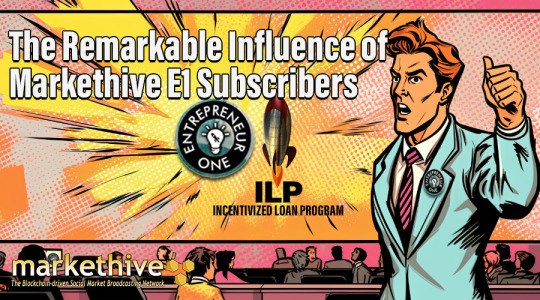
If you are one of the Markethive E1 subscribers who have been supporting the development of this innovative social network, you deserve a big round of applause. Your monthly contributions have helped build a powerful ecosystem that is transforming the way people communicate, collaborate, and professionally grow online. You are part of a visionary group shaping the internet's future.
Markethive is a social network with a purpose. Its purpose is to empower entrepreneurs, freelancers, artists, activists, and anyone who wants to make a positive impact in the world. The company respects your privacy, rewards your participation, and gives you access to cutting-edge tools and resources to help you achieve your business and personal goals.
Thanks to your support, Markethive stands out as a genuinely unique player in the world of social networking, inbound marketing, and cryptocurrency. It's a unique space where entrepreneurs connect and grow their businesses in a safe and supportive environment. And guess what? It's all made possible by your fantastic contributions, our noble investors.
Your monthly support isn't just about the numbers; it's about fueling the development of new features, improving the user experience, and broadening the platform's reach. This has turned Markethive into a social network that's truly one-of-a-kind. And you know what? It's all thanks to you.
When you invest in Markethive, it's not just about backing a platform; it's about supporting a movement. It is a movement dedicated to empowering entrepreneurs and helping them thrive in today's digital economy and a movement for you to attain financial freedom. Your monthly contributions are the powerhouse behind this incredible social network, and we're here to illuminate the extraordinary journey we've embarked on together. Cheers to building something extraordinary!

A Social Network with Heart
Markethive is a God-given vision that has a vibrant community with a beating heart. What truly makes Markethive stand out goes beyond its features; the authentic sense of community sets it apart. And guess what? You, with your unwavering commitment, are the reason behind this unique environment where members aren't just users but a supportive family.
In this community you've helped create, people don't just navigate through features; they support each other, share valuable knowledge, and cheer for each other's successes. Markethive, in essence, is more than a mere platform; it's a family, and you're the driving force behind the warmth and connection of this company.
Through your dedication, you've carved out a space where individuals from all walks of life can connect and grow together. It doesn't matter where someone comes from, how much experience they have, or what their goals are, Markethive is a place where everyone is welcome. It transcends being just a social network; it's a movement, and you, my friend, are the catalyst for this transformative change.
You have helped build a magnificent sanctuary that isn't just a space to market products or services; it's a place where meaningful relationships are formed, new skills are learned, and contributions to the common good are made. Markethive has evolved into more than just a social network; it's a hub of shared passions, and you are the reason behind that infectious passion. Cheers to creating a space that goes beyond the ordinary, where genuine connections and collective growth flourish!
Markethive: A Unique Competitor
One of the incredible things about Markethive is that it isn't just taking on the local scene; it's gearing up to compete with the heavyweights in the global social network and crypto project arena. What sets Markethive apart? It's not just about the tools and features; it's about the community, the spirit, and the commitment to empowering entrepreneurs.
In the vast landscape of social networks and crypto projects, Markethive stands out as a unique player, driven by a genuine passion for entrepreneurship and innovation. While others may focus solely on functionalities, Markethive places a premium on fostering a community of like-minded individuals who are not just users but active contributors to each other's success. So, as Markethive steps into the ring with other giants, it brings not just a platform but a movement dedicated to the rise of entrepreneurs and reshaping how they connect, collaborate, and thrive.
Your generous contributions have fueled the creation of a versatile space where entrepreneurs can do more than just dip their toes into the business world. Whether crafting a compelling blog, launching a dynamic campaign, connecting with like-minded individuals in a group, or gaining insights from a webinar, Markethive provides the infrastructure for entrepreneurs to expand their businesses.
The Ripple Effect: Your Investment, Our Collective Growth
Your E1 subscription is more than just a tick on your to-do list. It's like throwing a pebble in a pond, and the ripples? They're pretty darn amazing. When you sign up for the E1 subscription, it's not just about you; it's about a shared vision we're all painting together. Your commitment starts a ripple effect, and those ripples? They touch every corner of the Markethive community.
Now, why does this matter? Well, it's like planting a seed. Your investment grows into something much bigger, benefiting not just you but everyone in this dynamic Markethive family. Think about it: by backing our mission, you're not just getting the key to a toolbox; you're also handing out keys to others. Tools, resources, opportunities – it's like a treasure chest, and you're sharing the loot.
But it goes beyond that. Your support is like a booster for our innovation engine. It helps us fine-tune the platform, making it Fort Knox secure, ready to handle growth, and user-friendly for every tech level, from newbie to pro. And here's the cool part: your E1 subscription? It's not just a thumbs-up emoji for our vision. It's the fuel for our collective growth. Picture it as a bunch of friends on a road trip; everyone pitches in for gas, and suddenly, you're cruising farther and faster.
Together, we're not just building a platform but creating a wave of positive change. Your contribution might seem like a drop in the ocean, but guess what? Those drops add up, creating a tide that lifts all boats. So, keep riding this wave with us. Your investment isn't just about today; it's a high-five to the future. Let's keep creating those ripples, one subscription at a time, and watch how we can make a splash in the world. Let’s get ready for the ride.

Why Your Continued Support Matters
♦ Keeping the Innovation Wheel Turning
Keeping the innovation wheel turning is like keeping a good story rolling. It's all about the ongoing journey, not just a single chapter. At Markethive, we're on a mission to provide top-notch solutions for your online marketing adventures. Picture it like constantly adding cool twists and turns to a thrilling plot.
Your support is the fuel that keeps our innovation engine running smoothly. We're always cooking up new and improved tools, like a writer crafting a captivating sequel. Your feedback and suggestions? They're our plot twists, helping us fine-tune the narrative and make Markethive the go-to platform for all the entrepreneurial storytellers out there.
So, here's to you, our loyal readers and contributors. Together, we're shaping the ultimate success story in the ever-changing digital landscape. Cheers to keeping the pages turning and the innovation flowing!
♦ Expanding Reach and Inviting More to Join the Movement
This company is a fantastic ecosystem where dreamers, doers, and change-makers come together to make a positive impact. But guess what? We're not doing the solo journey; we want you on board!
Markethive empowers entrepreneurs, visionaries, and changemakers to pursue their dreams and positively impact the world. But we can't do it alone. We need your support to spread the word and invite more people to join our community.
By contributing to Markethive, you are helping us grow our network, enhance our features, and create more opportunities for everyone. You are also enriching the community with your unique insights, experiences, and skills. Together, we can make Markethive the ultimate hub for innovation, collaboration, and social good.
♦ Leave Your Mark on Markethive's Future
So, when we talk about Markethive, we're not just talking about a regular platform. It's a big project, a legacy in the making. Now, why do I say that? Your support and involvement in Markethive are like planting a tree that will keep growing and making a difference.
Think of it as leaving your mark on this mind-blowing social network. Your actions and your support all add up to something much bigger. It's not just about today; it's about the lasting impact you're making for the future. You're part of something extraordinary, and together, we're creating a story that will be remembered by generations yet unborn.
So, every time you engage with Markethive, you're essentially contributing to this bigger picture, leaving a kind of "indelible mark" – a mark that won't easily fade away. You are part of a journey where your steps matter, shaping what's coming next, which is this year. Markethive is launching from the depths of the oceans to the top of the highest mountains.
Conclusion: Together, We Build the Extraordinary
In wrapping up, we want to express our most profound appreciation for each Markethive E1 subscriber. Your contributions have transformed a vision into reality, creating an extraordinary social network that continues to redefine the landscape. As you consider your monthly E1 subscription, know that it's not just a transaction; it's a continued investment in something exceptional.
Your monthly subscriptions serve as the lifeblood of continuous innovation.
We thank you for your continued support and loyalty. We appreciate your trust and confidence in our vision and mission. We hope that you are happy with the results that we have achieved so far and that you are excited about the future that we are building together.
We also invite you to keep supporting Markethive and to spread the word about it. The more people join Markethive, the more value it will generate for everyone. The more E1 subscribers we have, the more resources we will have to improve and expand Markethive. The more feedback we get, the more we can tailor Markethive to your needs and preferences.
You are the reason why Markethive exists. You are the reason why Markethive is extraordinary. You are the reason why Markethive will succeed. Thank you for being the heart and soul of Markethive. Let's continue this incredible journey together! Remember, your E1 subscription makes Markethive extraordinary.


About: Prince Ibenne. (Nigeria) Prince is passionate about helping people understand the crypto-verse through his easily digestible articles. He is an enthusiastic supporter of blockchain technology and cryptocurrency. Find me at my Markethive Profile Page | My Twitter Account | and my LinkedIn Profile.
0 notes
Photo

New Post has been published on http://cryptonewsuniverse.com/2023-entrepreneur-one-bonus-fulfilled-2024-e1-bonus-opportunity-closing-soon-dont-miss-out-the-markethive-quest-will-make-history-will-you-join-us/
2023 Entrepreneur One Bonus Fulfilled 2024 E1 Bonus Opportunity Closing Soon Don't Miss Out The Markethive Quest Will Make History Will You Join Us?


2023 Entrepreneur One Bonus Fulfilled. 2024 E1 Bonus Opportunity Closing Soon. Don’t Miss Out! The Markethive Quest Will Make History. Will You Join Us?

Markethive is unyielding in its pursuit of innovation, striving for excellence in creating a groundbreaking platform that surpasses conventional social media and marketing tools. By prioritizing user experience, Markethive integrates advanced technologies that enable efficient broadcasting, expanding your reach and influence. Markethive's newly introduced Wallet, which serves as a comprehensive financial and accounting center, draws comparisons to a bank due to its capabilities, assets within it, and high level of security.
By embracing the cottage industry concept, Markethive creates opportunities for individuals to achieve financial independence within a sovereign and merit-based environment. This unique concept is entrepreneurial at its finest and is exclusive to Markethive, but its impact extends beyond the platform to the broader online community and cryptocurrency domain.
Markethive Has Delivered
Markethive, as promised, has delivered a highly complex, unique financial system unfathomable to most. This system is robust, impenetrable, and represents the future of serving entrepreneurs worldwide. Our progress has been made possible by the unwavering support and contributions of the Entrepreneur One community and ILP holders.
These individuals recognize the tumultuous state of the world and believe that Markethive's vision holds the key to freedom of speech and financial independence for those who embrace its framework. By leveraging Markethive's tools and systems, businesses can flourish, and individuals can secure a brighter future for themselves and their communities.
The Entrepreneur One members (E1) also gain advantages from Markethive's generosity through the Initial Loan Procurement or Incentivized Loan Program (ILP), positioning themselves for long-lasting financial prosperity through the income generated by Markethive's retail products. Markethive's various sources of revenue will supply the funds required to make interest payments to E1s and ILP participants.

Entrepreneur One Loyalty Bonuses
Accordingly, Markethive rewards the loyalty of Entrepreneur One members by granting them annual bonuses in the form of ILPs. Note that the 2023 bonus of one whole ILP to each E1 associate who has maintained their subscription for the past 12 months has been credited to your wallet.
The 2024 bonus, which consists of one full ILP and 1000 Hivecoins, was recently announced. This reward will be given in January 2025 after a 12-month period. Only Entrepreneur Ones are eligible for this initiative, but for a short time, free members can upgrade to an E1 membership for $100 per month. To qualify for the bonus, members must maintain an active subscription for 12 consecutive months, and they will receive one complete ILP and 1000 HVC in January 2025.
You have until January 31st, 2024, to take advantage of this offer and secure an Entrepreneur One subscription, making you eligible for the bonus. Time is of the essence, as less than two weeks remain before this opportunity expires.
It’s important to note that Markethive does not engage with prominent venture capitalists to secure funding. Instead, we depend on our community, as we prefer to contribute back to the community. The ILP can be likened to shares in the company. The only difference is that it functions as a loan from you to Markethive, considered an assumable note. Since it is a debt instrument, it is not subject to taxation.
Despite the significant advancements we have achieved in the advancement of our system, there are still crucial elements that require completion before we can proceed into the retail products phase. These products will yield substantial profits for Markethive and its entrepreneurial contributors. Thus, your assistance is still vital to help us reach this goal.
Entrepreneurship Threatened
Entrepreneurship is being threatened throughout the world by a collectivistic ideology of the 1%. The global elites are infiltrating governments globally with the imperative to assist them in their quest to fix the issues in the world, such as poverty (among other matters), with the notion of equality, diversity, and inclusiveness.
However, they are killing the free market and pure capitalism. Not cronyism, which, unfortunately, many believe is capitalism, but true capitalism in which entrepreneurs thrive. An entrepreneurial world fosters growth of all kinds: personal, industrial, financial, and creative. It also encourages critical thinking, freedom of expression, sovereignty, and liberty for all. This attempt at oppression in Western countries, where freedom is sacrosanct, has been in execution for decades, with an awakened minority daring to stand up to them and their corruption.
One Historic Speech That Says It All
Several speeches and quotes throughout history have deeply moved global society and invoked a sense of wisdom in an attempt to change the world. However, these speeches have been brushed aside by the evil globalists, who are virtue signaling well-being for humanity while actively devising the complete opposite.
President John F Kennedy had a profound impact on citizens across the world as he stood against tyranny and fascism. He was a true leader and humanitarian who cared for society but couldn’t do it alone. He asked his fellow Americans, “We the people,” to join him in a stoic effort to defend Freedom so that civilization could enjoy the blessings of a fruitful life. The following is an excerpt from President Kennedy’s heartfelt speech in the Inaugural Address in 1961.
"…Now, the trumpet summons us again. Not as a call to bear arms, though arms we need. Not as a call to battle, though in battle we are, but a call to bear the burden of a long twilight struggle year in and year out, rejoicing in hope, patient in tribulation, a struggle against the common enemies of man â tyranny, poverty, disease, and war itself. Can we forge against these enemies, a grand and global alliance? North and South, East and West that can assure a more fruitful life for all mankind. Will you join in that historic effort?
In the long history of the world, only a few generations have been granted the role of defending freedom in its hour of maximum danger. I do not shrink from this responsibility; I welcome it.
I do not believe that any of us would exchange places with any other people or any other generation. The energy, the faith, the devotion, which we bring to this endeavor will light our country and all who serve it, and the glow from that fire can truly light the world.
And so, my fellow Americans, ask not what your country can do for you; ask what you can do for your country. My fellow citizens of the world, ask not what America will do for you but what together we can do for the freedom of man.
Finally, whether you are citizens of America or citizens of the world, ask of us here the same high standard of strength and sacrifice which we ask of you. With a good conscience, our only sure reward with history, the final judge of our deeds, let us go forth to lead the land we love, asking His blessing and His help, but knowing that here on Earth, God's work must truly be our own."
– J F Kennedy. Inaugural Address, – January 20th 1961
The essence of the passage above correlates with Markethive and its Divinely inspired vision to provide a haven for freedom of speech, personal and financial sovereignty, and a God-given right to prosperity, abundance, and well-being. We are the generation chosen to fight for and deliver this vision in these dark times.
In the spirit of what President Kennedy said to his congregation, the energy, faith, and devotion we bring to Markethive’s endeavor will light our ecosystem and all who serve it, and the glow from that fire can truly light the world. Additionally, ask of us here at Markethive the same high standard of strength and sacrifice that we ask of you.
Thomas Prendergast, founder and CEO, has dedicated his life and every last penny to the Markethive vision, a truly selfless undertaking to lift entrepreneurs and restore the spirit being stripped away by oppressive measures. We boldly declare our determination to remain unyielding against oppressive rulers in the international arena. We refuse to be deterred by the ideologies of communist regimes or the ambitions of the global elite seeking to establish a new global order. So we ask of you, will you join us in this historic effort?
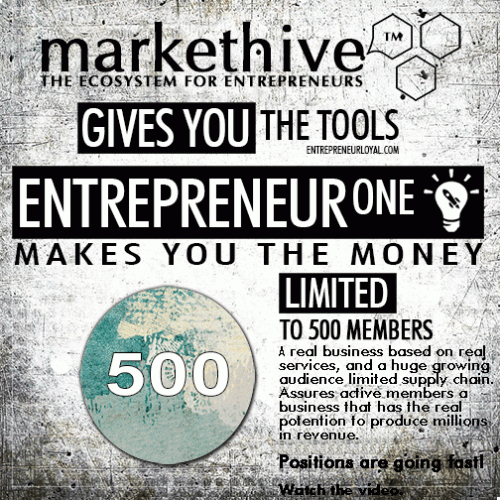
So, Will You Join Us In This Historic Effort?
Every one of us is engaged in this shared vision of a global entrepreneurial sanctuary that champions individual freedom. Many of you have been indispensable in shaping our journey thus far. We've made tremendous strides in building this system and are now on the cusp of sharing it with the world. However, we require additional support to realize our vision fully.
We need more of you who possess the power to drive us forward by obtaining an Entrepreneur Account or reinstating your existing Entrepreneur One account. Alternatively, you can also purchase an extra Entrepreneur One account. Together, we can reach new heights and make a lasting impact on the world.
Remember, by subscribing to Entrepreneur One, you are lending funds to Markethive and supporting its mission to create a cutting-edge platform that will revolutionize the way we network and do business. As a subscriber, you'll play a crucial role in shaping the future of entrepreneurship and reap substantial financial rewards for your commitment and perseverance.
We look forward to sharing the prosperity of this groundbreaking giant in the tech, social media, marketing, and crypto industries with all of you at Markethive. Providing financial support is to be a voice that persistently advocates for freedom, autonomy, critical thinking, and expression. Rather than surrendering to obscurity, we are constructing a realm that illuminates the path and unites entrepreneurs and fellow visionaries to establish a more ethical and transparent business environment. â An ecosystem that contributes to your livelihood and empowers you with financial freedom.
May God grant us all with wisdom, faith, and serenity.


Editor and Chief Markethive: Deb Williams. (Australia) I thrive on progress and champion freedom of speech. I embrace "Change" with a passion, and my purpose in life is to enlighten people to accept and move forward with enthusiasm. Find me at my Markethive Profile Page | My Twitter Account | and my LinkedIn Profile.
0 notes
Photo

New Post has been published on https://cryptonewsuniverse.com/building-the-markethive-kingdom-for-the-2024-launch/
Building the Markethive Kingdom for the 2024 launch


Twenty-six years ago, the Lord set me on a path to build a kingdom for the end times. Twenty-six years ago, the end times seemed so far away, a distant reality.
youtube
So we set about building it – We scaled mountain after mountain, we crossed valley after valley, and we built a secure system that delivers email unlike anything else. It delivers almost 100% directly to the inbox.
We built a state-of-the-art inbound marketing system that became a social network of fellow entrepreneurs working together for a common cause to build an ecosystem to stand the test of time in what is the end times era prophesied centuries ago—an out-of-control political world that is out to tear down and destroy entrepreneurs.
We built a system that will boldly stand against that agenda, stand tall in the mountains, and be this blinding light of God's glory of entrepreneurs that will never ever go away.
We built a system that will broadcast the word of freedom to every corner of the world. This year, we need you more than we have ever needed you because it is this year, we're going to kick off this huge system and launch it into something the world has never seen.
The world is going to discover a system that has been built by the Breath of God. A vision that will create a sanctuary for our brothers and sisters who are entrepreneurs who wish to build a better life. Who wish to build a solid family of like-minded individuals, who wish to build a home that is stable, secure, and financially viable, that won’t be ripped out from under them and canceled by the woke mind virus that is proliferating in every sector of every industry.
We have built that system, and we are about to disclose it to the entire world, and we need you. We need every single one of you to pull out a little more to go get an Entrepreneur Account, to take the Entrepreneur One account you already have, and restore it or reactivate it. To buy additional Entrepreneur One accounts.
These E1 subscriptions are loans to Markethive to assist us with development as we build this unparalleled system to eclipse systems like LinkedIn. The financial return you will receive on this is going to be massive, and you are part of this.
We're all part of this vision and want to reward your spirit of determination, your foresight, and your mettle that continues to stand up for all our freedoms and autonomy. Your contributions are important to drive this vision to the next level of building the retail giant of liberty on a massive global scale.
We are making a statement here that we will not be stopped by tyrants of the world. We will not be stopped by the agendas of the communists and the global elites’ new world order.
We will become a system that will exist in every nation and every country in the world. We will become a kingdom built on thousands and thousands of cloud systems scattered worldwide, underpinned by blockchain, crypto-energized, and a database system that will withstand a community of millions and terabytes of creative contentã
¡a database system that cannot be stopped.
So I have to ask you. What are you going to do? Are you going to be part of this? To contribute financial support is to be that voice that will never give up or go quietly into the dark.
Instead, build the kingdom that will light up the way to stand with the other entrepreneurs, building towards a better way to freely conduct business in an open, honest, and transparent environment. A meritocratic social network of critical thinkers that is so needed in these dark times of subliminal brainwashing. An ecosystem that contributes to your livelihood and financial freedom.
I have dedicated my entire life to this moment, to this building of this Markethive vision. I have spent my entire life putting every penny I have into it. Many of you have, too, and I ask you: Give more; let's make this big. Let's blow it up in 2024. Let the giant rise out of the ocean in 2024, along with the millions of multitudes of entrepreneurs who say we will not go away.
Thank you. God bless you.
Thomas Prendergast CEO
To discover the Entrepreneur System and what it can do for you and your future tap here:
markethive.com/group/1146/blog/markethivesreasonforbeingandmagnanimityentrepreneuroneadivinelegacy
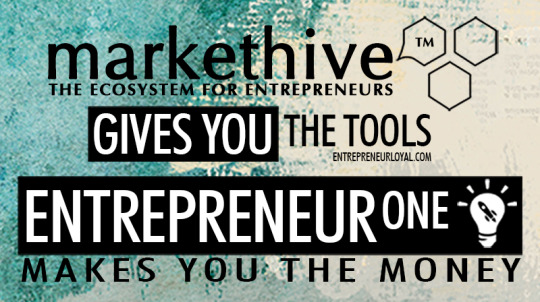
0 notes
Photo

New Post has been published on https://cryptonewsuniverse.com/on-chain-data-in-a-volatile-market-how-traders-stay-ahead-of-the-curve/
On-chain data in a volatile market: How traders stay ahead of the curve

Exploring the role of on-chain data in helping traders navigate the volatile cryptocurrency market.

Market volatility, a defining characteristic of the crypto realm, introduces opportunities and risks, demanding a nuanced understanding and adept strategies for effective decision-making. Within this dynamic environment, the significance of on-chain data emerges as a crucial tool for traders seeking to navigate the intricacies of volatile markets.
On-chain data, a term resonating within the realms of blockchain and cryptocurrencies, refers to the wealth of information derived directly from the blockchain. This includes transaction data, wallet balances, and various metrics that capture the activities taking place on the blockchain.
Understanding on-chain data is crucial for unraveling the complex dynamics of the cryptocurrency world. Simply put, on-chain data includes a detailed set of information directly from the blockchain. This information covers various transaction details, wallet balances and metrics that create a clear record of activities on the blockchain.
Unlike traditional financial markets, where data goes through centralized entities, on-chain data provides an unfiltered and decentralized view of interactions in a blockchain network.
Harry Dinh, the chief data scientist of on-chain analytics platform Spot On Chain, told Cointelegraph, “What sets on-chain data apart from traditional financial market data is the decentralization, transparency and immutability nature.”
Dinh said, “During market volatility, while traditional financial markets may have delays in reporting, on-chain data offers real-time transparency, allowing investors to detect unusual patterns promptly and independently without relying on centralized authority. As a result, on-chain data enhances reliability and reduces the risk of manipulation.”
On-chain data in action
To understand on-chain data effectively, it’s crucial to concentrate on fundamental metrics and indicators that shed light on a blockchain’s functionality.
These include the volume of transactions, the number of wallet addresses, the frequency of transactions and the movement of tokens. These metrics are tools for analysts and traders to detect patterns, trends and irregularities in the blockchain.
On-chain data becomes a practical guide by exploring specific metrics that stand out during turbulent times. These metrics act as essential tools for traders trying to understand the market’s underlying dynamics.
The connection between these on-chain metrics and subsequent market shifts forms a compelling story, emphasizing the predictive potential of analyzing blockchain data.
Blockchain analytics tools like Spot on Chain can be used to track wallets and token movements related to venture capitalists and whales. Crypto traders and investors could use this information to gain insights into the activities of major entities in the crypto space.
Edited
0 notes
Photo

New Post has been published on http://cryptonewsuniverse.com/markethive-gearing-up-to-launch-its-ico-with-a-difference/
Markethive Gearing Up To Launch Its ICO With A Difference


Markethive Gearing Up To Launch Its ICO With A Difference

And It's Not an IEO, Not a STO, Not an IDO
Continuing from our previous article, the allure of Initial Coin Offerings (ICOs) has diminished in recent years. An ICO is a process in which a cryptocurrency startup endeavors to generate interest in its digital currency project by promoting it on its website. This was a new phenomenon in crypto and financial markets in general, allowing individuals to purchase the newly created crypto token directly from the company behind the project.
No restrictions or regulations were involved, and speculation rather than substantial foundations drove the majority of ICOs. Much of the hype surrounding ICOs attracted casual investors who hoped to achieve significant financial gains despite these projects often being based solely on concepts.
Numerous ICOs faced issues with regulatory entities as their tokens were classified as securities rather than utility tokens, resulting in multiple cryptocurrency companies being required to pay fines and reimburse investors. In the United States, the Securities and Exchange Commission (SEC) has struggled to establish a legal definition for tokens in cryptocurrency since the emergence of Bitcoin.
While ICOs were initially created to generate funds in a space without regulations, many deceitful ICOs were launched to exploit unsuspecting investors. By the end of 2017, China enforced a ban on ICOs, causing the cryptocurrency industry to search for alternative methods to finance emerging enterprises. This article will explore the various alternatives for ICOs and delve into the plans for Markethive's utility token, Hivecoin, in the coming year.

Source: Binance Square
Initial Exchange Offering (IEO)
Initial Exchange Offerings (IEOs) are fundraising events for crypto start-ups to raise funds through a trading platform. They occur on a crypto exchange for the company launching new tokens. One advantage is that investors may have greater trust as they witness a crypto token sale on a reputable crypto exchange, which enhances the project's credibility.
To raise funds on the exchange, start-ups must pay a fee and give a percentage of the tokens they sell. Once the Initial Exchange Offering (IEO) is finished, the tokens are listed on the exchange, which increases the company's visibility to potential investors. Unlike Initial Coin Offerings (ICOs), where contributions are sent directly to smart contracts, participants in an IEO send their contributions through the hosting platform.
IEOs have gained traction among major cryptocurrency exchanges. Binance Launchpad was among the initial platforms to introduce IEOs in the market, leading to other exchanges quickly adopting the same approach. The primary benefit of these offerings is the enhanced transparency and trust they provide. Since a reputable cryptocurrency exchange carries out the token sale, the risk of fraudulent activities and scams is considerably lower than ICOs. Reputable platforms conduct thorough assessments of projects before making them available to users.
There is a contention that IEOs do not offer higher security compared to ICOs. In the worst case, they can be seen as centralized authorities that control the types of projects that emerge. Furthermore, projects must pay to be included on a centralized exchange, limiting the opportunity to be featured to moderately established projects, not just concepts. Additionally, they may be required to sign agreements restricting them from listing tokens on competing exchanges.
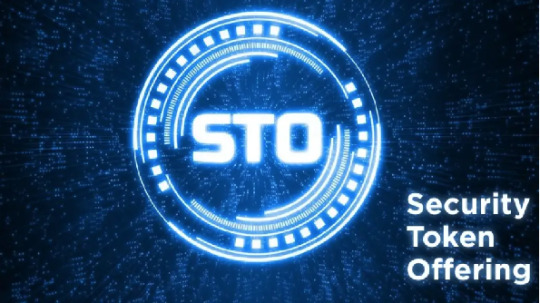
Source: Tokenminds
Security Token Offering (STO)
STOs, or Security Token Offerings, are a relatively new way of raising funds using blockchain and cryptocurrency. They provide an alternative to typical equity investment and are among the most exciting emerging trends in cryptocurrency. Security tokens serve as virtual representations of ownership in various entities such as companies, financial products, investments, securities, and commodities, granting individuals ownership rights in the underlying value of these assets.
The challenges and constraints of obtaining funding from conventional sources have led to the popularity of alternative methods, such as STOs, for sourcing capital. STOs fully comply with laws and regulations, providing a secure means for companies to secure funding. They serve as a platform for start-ups, established businesses, and traditional institutions to raise funds by issuing digital tokens.
STOs are a category of tokens that represent legal ownership of tangible assets in the real world. They provide the opportunity for individuals or entities to obtain ownership rights in digitally secure assets and symbolize ownership in valuable assets such as real estate or company shares. This contrasts the conventional Initial Public Offering (IPO) process, in which companies become listed on the stock exchange.
Instead, companies have the option to create a new enterprise or utilize an already established one with the assistance of smart contracts. These smart contracts are automated legal agreements between two parties stored on public blockchains. This minimizes the challenges encountered in transactions, including issues like fluctuating prices, fraudulent activities, and regulatory compliance complications.
Security tokens are also utilized in the practice of crypto-fractionalization, which involves securing real-world assets through the process of tokenization. Various real-world assets, including real estate, capital markets, commodities, and equity funds, can be tokenized. STOs are specifically designed to meet the regulations set forth by global regulatory bodies such as the U.S. Securities and Exchange Commission (SEC).

Source: Hackernoon
Initial DEX Offering (IDO)
An Initial DEX Offering (IDO) is a contemporary way of crowdfunding or fundraising that occurs on a decentralized exchange (DEX). Unlike previous methods, such as Initial Coin Offerings and Initial Exchange Offerings, where the sale of tokens was controlled on centralized platforms, IDOs offer a transparent platform on a DEX that enables crypto projects to issue and sell tokens to users directly.
The approach has transformed from ICOs, which were troubled by problems like fraud and inconsistencies, to more controlled formats, such as IEOs and STOs. In 2013, the first initial coin offering was held by Mastercoin Protocol, raising $500,000 worth of bitcoin (BTC). IDOs gained attention in 2019 when Raven Protocol made the announcement of the first IDO on Binance DEX.
IDOs have been improving their approaches since they were first introduced, becoming more popular because they are affordable, have fewer restrictions, and give power to individuals instead of central entities. As a result, they have significantly changed the way crypto fundraising is done. IDOs also provide a simpler and more affordable option for smaller projects to release their tokens instead of using more significant centralized exchanges. To ensure fairness, IDOs often have measures to prevent a single investor from purchasing a large quantity of tokens.
On the other hand, it is easier for projects with a questionable reputation to distribute their tokens via IDOs rather than through IEOs on regulated exchanges because there is less oversight on the projects. Moreover, IDOs bypass regulatory approval, increasing the risk of scams and fraudulent activities. Despite these risks, IDOs illustrate a promising advancement in crypto fundraising, demonstrating how the decentralized nature of the crypto ecosystem continues to evolve.

Source: Markethive
Markethive’s One-of-a-kind ICO for Hivecoin
As discussed in a previous article, many fall victim to ICOs. The hype and speculation of its newly minted crypto token are sold to wannabe investors on the promise of high returns and the revolutionary technology and purpose it claims to serve, even though no tangible evidence of its effectiveness exists. 99% of ICOs don’t do what they say they will do, resulting in the naive investor getting stuck “holding the bag” of worthless tokens. Meanwhile, the individuals responsible for the ICOs swiftly exit after amassing substantial funds, seemingly vanishing without a trace.
Markethive is in preparation to launch an ICO-like event, which differs from other coin offerings because it already has an operational system and delivers what other ICOs only promise to give when they commence their fundraising. It's worth noting that Markethive has never conducted an Initial Coin Offering.
So far, Markethive’s progress has been made possible by utilizing small amounts of money in the form of a loan from members who have subscribed to the Entrepreneur One Upgrade (E1), earning portions of an ILP in return. Additionally, some members have directly purchased ILPs, which also contributes to the development. This method is significantly different from the traditional ICO approach.
As stated by CEO and founder Thomas Prendergast,
“It’s time to raise money to market and promote Markethive and bring in the millions, if not billions, that can benefit from what Markethive offers. We will raise money not based on speculation but on fact. We’ve already built the system and have our coin with everything ready to go, making Markethive’s ICO very different from all others that have already done ICOs. That should actually have a significant impact on the industry.”
Thomas also shared his deep concern about the growing population of individuals who are experiencing poverty and financial burden as a result of being deceived, manipulated, and defrauded by online scams. He stated that this concern serves as a driving force behind the development of Markethive, an extensive undertaking intended to establish a platform that can generate a genuine and sustainable income for its users. While Thomas prefers not to speculate on specific timelines, he maintains that despite the obstacles encountered by Markethive, 2024 appears to be the year when everything will come together.

Source: Markethive
So What’s Markethive Got Already?
Markethive offers various features and assets. It has a fully operational wallet and has introduced its cryptocurrency called Hivecoin. With a total quantity of 45 million, Hivecoin is currently used within the platform to make payments and provide incentives. The Markethive Wallet consists of multiple wallets serving different purposes.
It’s an Accounting system.
It houses The vault.
It’s used for Payments.
Incorporating a Bitcoin wallet, Solana wallet, and Hivecoin wallet
With its current operational platform, Markethive offers a range of tools and services currently being improved through iterations and UX enhancements. The fundamentals consist of;
A full-blown marketing platform.
Social network
Inbound Marketing
Storefronts
Promocodes
Customer acquisition
Lead generation
Marketing tools
Markethive’s iterations and UX enhancements will incorporate multiple feeds and be likened to;
Twitter, a microblogging feed
YouTube, a video feed
Google Blogger, a blogging feed
Scoop.it, a curation feed.
Markethive has been at the forefront of introducing unique initiatives and projects that remain unparalleled in the industry. It combines an automated marketing system, an inbound marketing platform, and a social network. By merging various types of social networks into one and transforming it into a broadcasting platform, Markethive has established itself as a pioneer. With a rapidly expanding community of over 200,000 members, Markethive continues to flourish.
The Next Four Big Milestones
1: E1 Exchange. The EX1 permits the purchase and sale of Entrepreneur One subscriptions. E1 is an exclusive framework created to financially support Markethive and provide users access to all the platform's tools. Since the company will no longer offer E1 subscriptions, the only means of obtaining one is through the E1 marketplace, where existing E1 holders may choose to sell, making it a highly valuable and scarce asset.
2: Promocode System. The Markethive admin panel has a promocode system that generates unique codes for E1 members. These codes offer giveaways like Hivecoin, Markethive credits, Boosts, and Wheel of Fortune spins. Each E1 member will receive a specific promocode to promote Markethive on different websites and attract potential users. Any signups, bonuses, or airdrops resulting from these promotions will be credited to the person who acquired the prospect.
Entrepreneur One members will also be provided with a control panel where they can create their own Promocodes. They can select the rewards to offer, which can be purchased through the shopping cart. Additionally, Promocodes can be used for individual groups or storefront signups. For example, if someone joins your group, they will receive a gift. The Promocode is made for Markethive’s social network and has never been done in this industry.
3: Premium Upgrade. The Premium upgrade will replace the E1 upgrade. Those with Premium upgrades will have access to all the features and benefits of the E1 package, except for ILPs or Banner Impressions. The cost for the Premium upgrade will be significantly lower than the E1, which is $100 per month and will be classified as a retail product that generates revenue.
4: Login Registration and Incentive. Upon signing up for Markethive, you will be required to complete the Know Your Customer (KYC) process. You will have 30 days to do this, as indicated by a countdown clock that will periodically remind you. After completing your KYC, you will receive a free 30-day Premium Upgrade. Additionally, you will be eligible for an HVC airdrop, and if you used a Promocode during registration, you will also receive all the incentives associated with that particular Promocode offer.
The KYC procedure has been streamlined and now involves recording a brief one-minute video of yourself to demonstrate your identity and provide your credit/debit card information. A small sum will be deducted as part of the verification process. It is worth mentioning that you do not need to submit any other forms of identification. Please be aware that you will only receive bonuses, airdrops, or promocode offers once you have successfully completed the KYC process.
An added bonus is that once KYC status is fulfilled, it will allow you to withdraw HVC from your Markethive wallet; however, in keeping with our security protocols, you must activate the 2FA authenticator to access your wallet.
On completion of these milestones and the Markethive ICO websites to be used in the ICO campaign, Markethive will embark on an ICO-like event to fund the marketing of these milestones and increase Hivecoin awareness. The funds raised will also pay for the cost of an ICO-dedicated platform and employ it to launch Markethive’s ICO and to guide Markethive on the ICO journey.
While it is unnecessary for Markethive to be listed on a cryptocurrency exchange to launch an ICO, it would be advantageous to have one. In addition to Markethive’s plans of establishing their own dedicated offshore crypto exchange, Markethive is vetting various crypto exchanges for listing Hivecoin and introducing Markethive to the global cryptocurrency market.
Exciting Update for Members of Entrepreneur One!
Every single Entrepreneur One member will receive the signups resulting from the ICO campaign as well as the Promocode site to promote the ICO and with incentives such as Markethive giveaways.
This is the year when Markethive becomes revenue-oriented and retail-oriented with the new dashboard, state-of-the-art capture page system, and autoresponders. These are retail products and are separate from the free marketing system provided to free members.
Additionally, Markethive will promote its system and launch an ICO-style campaign to drive in the multitudes, with the aim of having hundreds of millions of members in the Markethive system. Markethive is expanding the scope and depth of its vision in what it's building for all humanity. 2024 really looks like the year Markethive will ascend to new unprecedented heights and give back to the community that has upheld the Markethive vision.


Editor and Chief Markethive: Deb Williams. (Australia) I thrive on progress and champion freedom of speech. I embrace "Change" with a passion, and my purpose in life is to enlighten people to accept and move forward with enthusiasm. Find me at my Markethive Profile Page | My Twitter Account | and my LinkedIn Profile.
0 notes